From repurposed mining relics to a colourful cultural revival, here are the things to do in Ostrava, Czech Republic, that will change your perceptions of this former industrial city.
When the last mine in Ostrava closed in 1994, it left a city in economic collapse, with a sooty smattering of factories, a towering skyline of headstocks and blast furnaces, and an underground of abandoned shafts. The third largest city in the Czech Republic had to reinvent itself.
In a two-decade-long progressive cultural revival, Ostrava repurposed the relics and empty shells of its industrial past into educational and artistic spaces. It turned the site of its first ironworks into a stage for the annual Colours of Ostrava music festival, now one of the biggest music events in Central Europe. The once drab and functional city centre teems with culinary hotspots, speciality coffee shops, concept design stores and urban art.
Yet Ostrava is still massively overlooked, as it tries to shake off the lingering “black Ostrava” nickname of its mining heritage while vying for the attention of travellers heading straight for Prague at the other end of the country. Ready to see it differently? Here’s how.
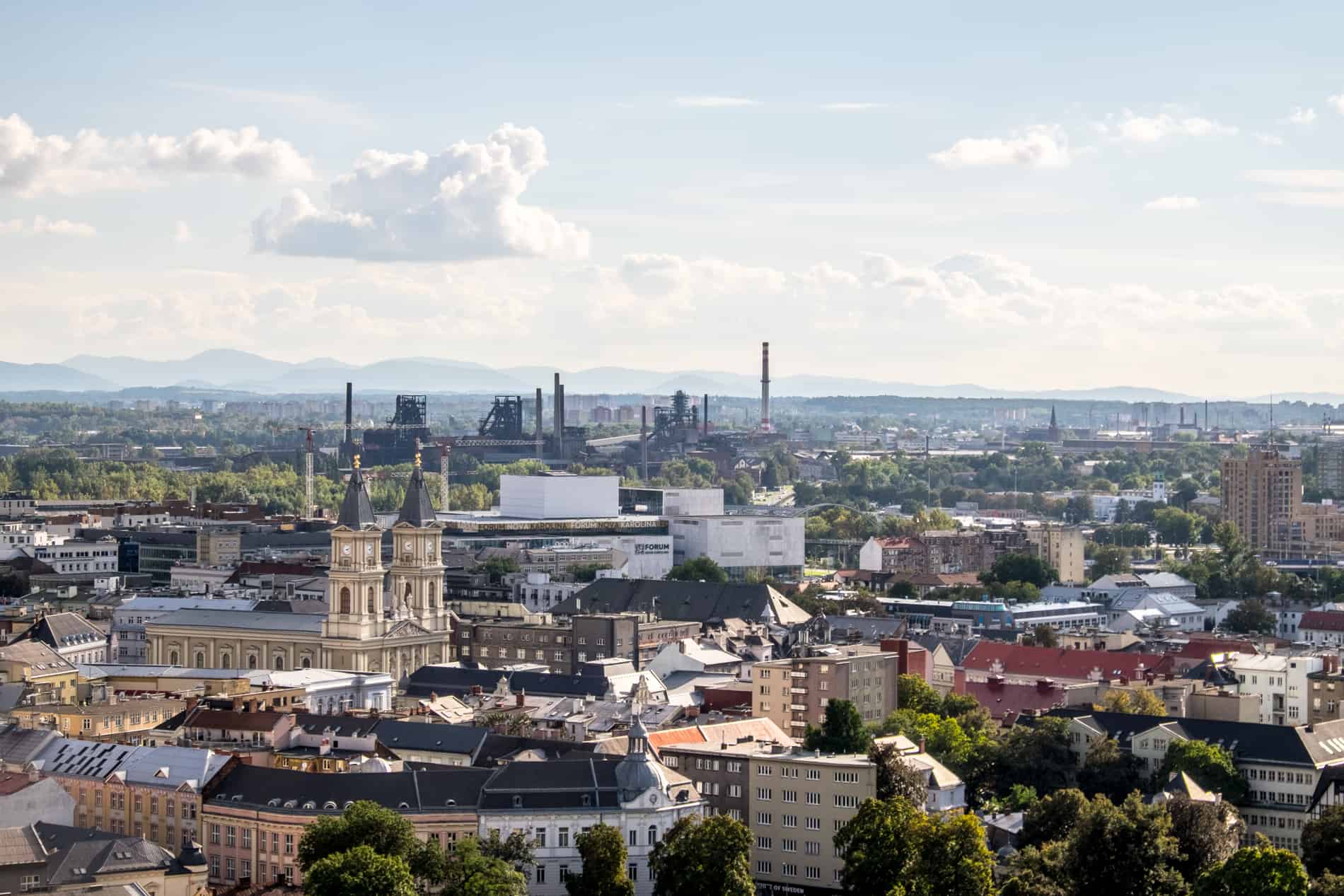
There are many alternative attractions and uncommon things to do in Ostrava, Czech Republic, to see It differently.
The History of Mining in Ostrava
Before the First World War, Ostrava wasn’t a dazzling Habsburg cultural centre like Prague but an economic and industrial bastion of the Empire sitting on a coal basin. The Dolni Vitkovice ironworks was built in 1828 to produce the materials for the bourgeoning railroad network. Post-Second World War Communist Czechoslovakia kept the industry on full throttle, and Ostrava became a worker’s “city of coal and iron”, and the excelled “steel heart of the republic”.
After the Velvet Revolution in 1989 that ended communist rule, the dissolution of the Soviet Union in 1991 and the splitting of Czechoslovakia in 1993, coupled with the negative environmental and health impacts, it all fell apart. And like most mining towns, there wasn’t a Plan B.
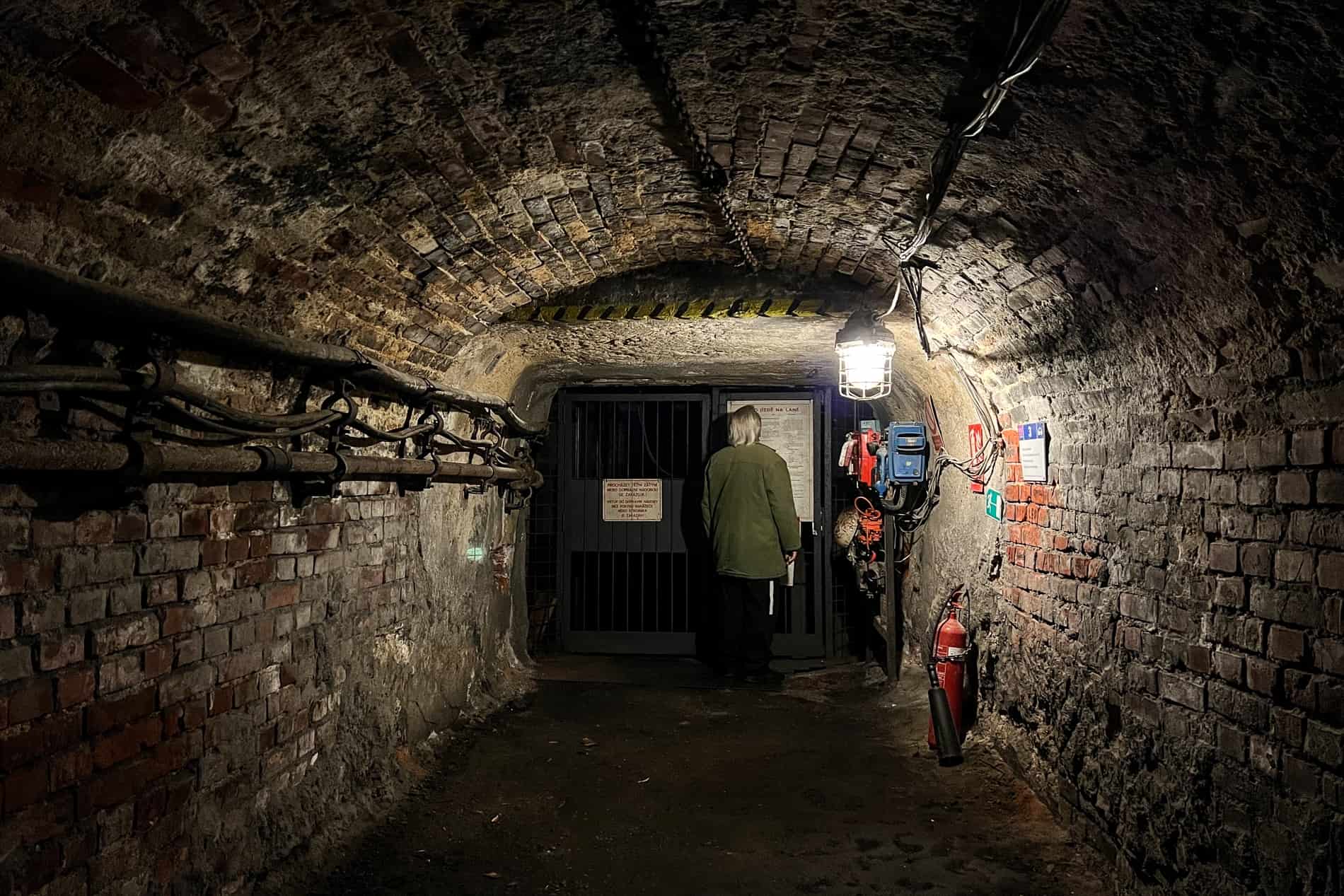
Understanding the industrial heritage of Ostrava at a mine 250m below ground.
Where Is Ostrava?
Off the beaten tourism trail, Ostrava is not the first city people think to visit in the Czech Republic. The capital of the Moravian-Silesian Region is wedged in the far north-eastern pocket of the country that meets the borders of Poland and Slovakia and is often overshadowed by Brno 170km below it, the quirky and cool capital of South Moravia.
Is Ostrava Worth Visiting?
If you are curious-minded, looking to understand just how different Czech cities are from one another or want to see how somewhere with a complex heritage can revive itself to become compelling to visit, then Ostrava is the place. A defiant and unpretentious city still in cultural flux, you might be surprised how much you enjoy it.
What to See in Ostrava City Centre
Don’t believe everything you hear about Ostrava being an ugly city – plenty of pretty pockets, green spaces, and artistic platforms are to be sought out.
Find Old Ostrava in Masaryk Square
Masaryk Square is a quintessentially pretty corner of Ostrava, ringed with pastel-hued buildings, the historic former city hall building and a 12-metre-high baroque plague column. Behind the square is another of the city’s oldest buildings, St Wenceslas Church, hidden within a cluster of modern facades. Inside the old city hall building is the Ostrava City Museum, detailing a timeline of the city through archaeological relics and themed exhibits.
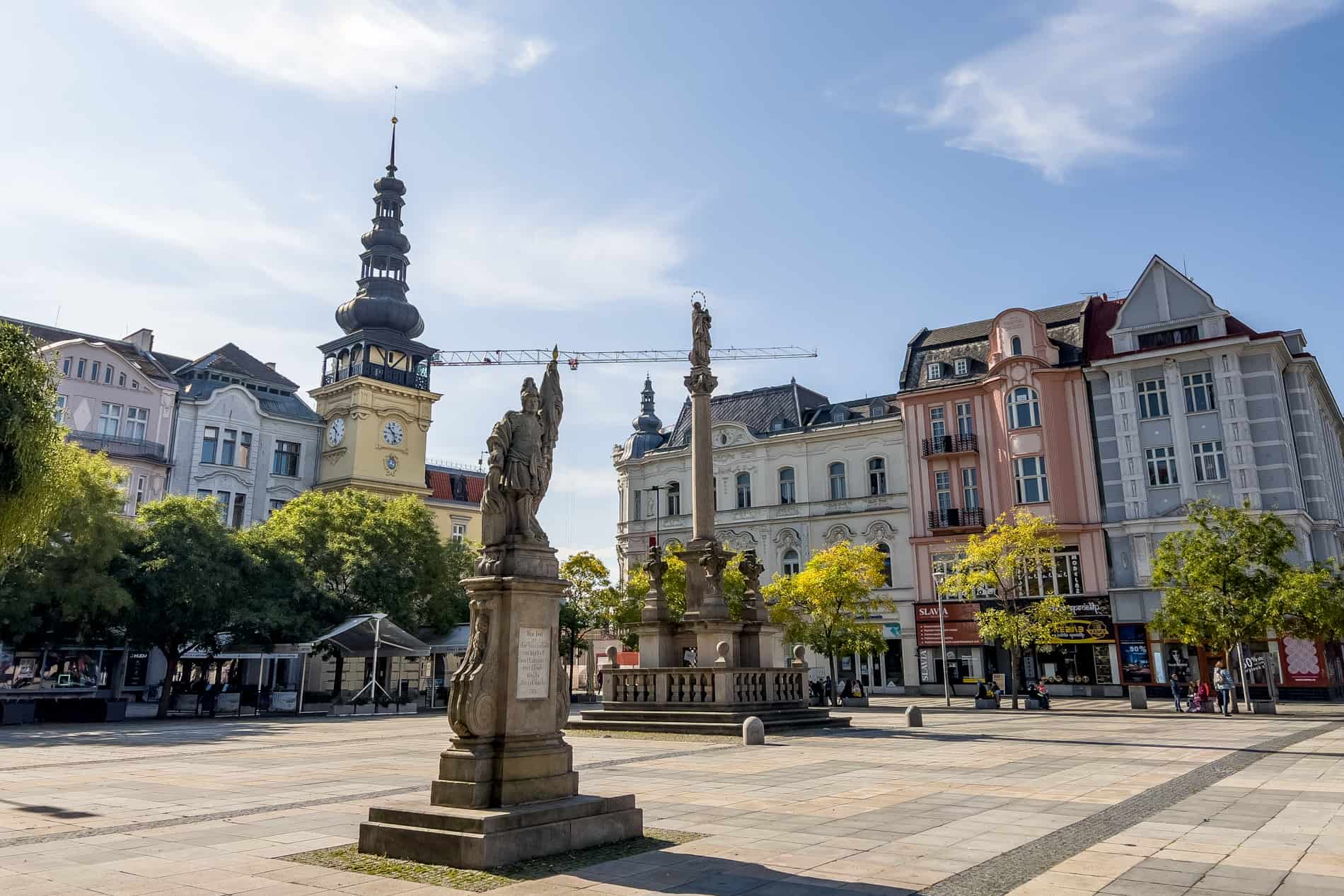
The pretty centre – Masaryk Square, Ostrava.
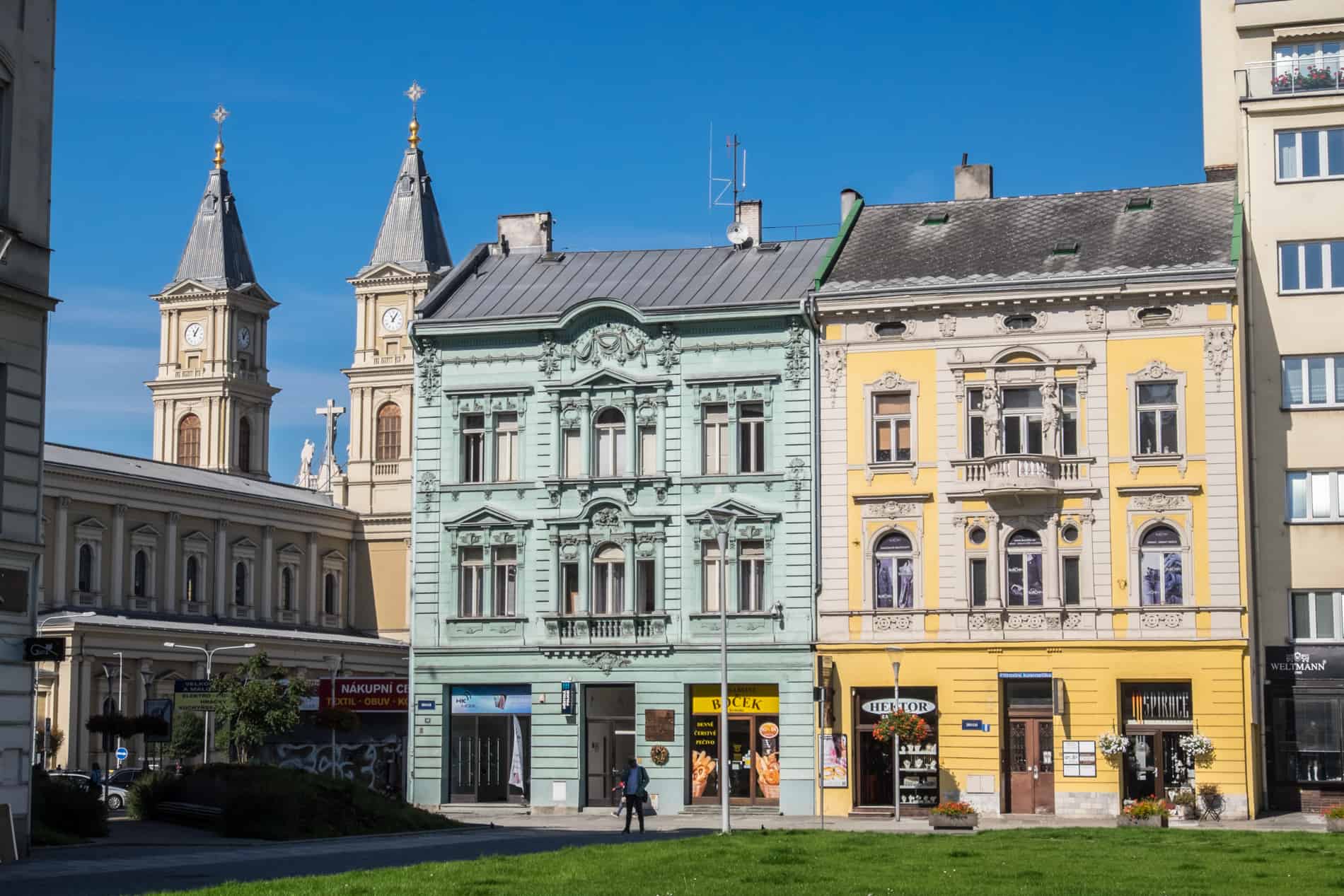
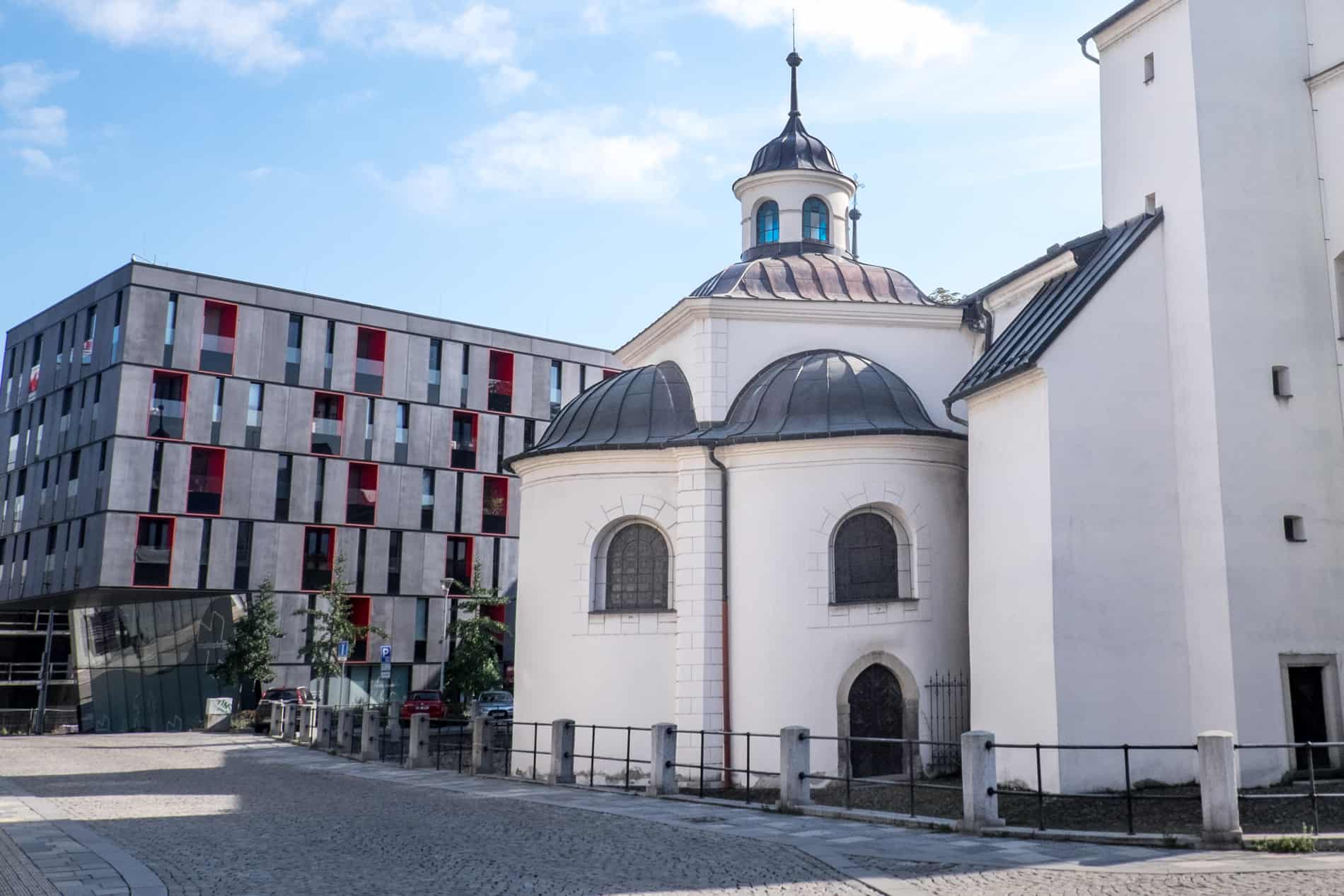
The 13th-century St Wenceslas Church.
See the Madona Street Art Mural
Claims of a lot of street art in Ostrava lead to disappointment, but the one significant artwork there has become a city symbol. The ‘Ostravská Madona’ or ‘Meredith’ mural on the wall of a former textile department store is of a woman whose upward gaze is said to resemble hope. It can be found at the end of the long 28 října (street) and in front of the historic Imperial hotel.
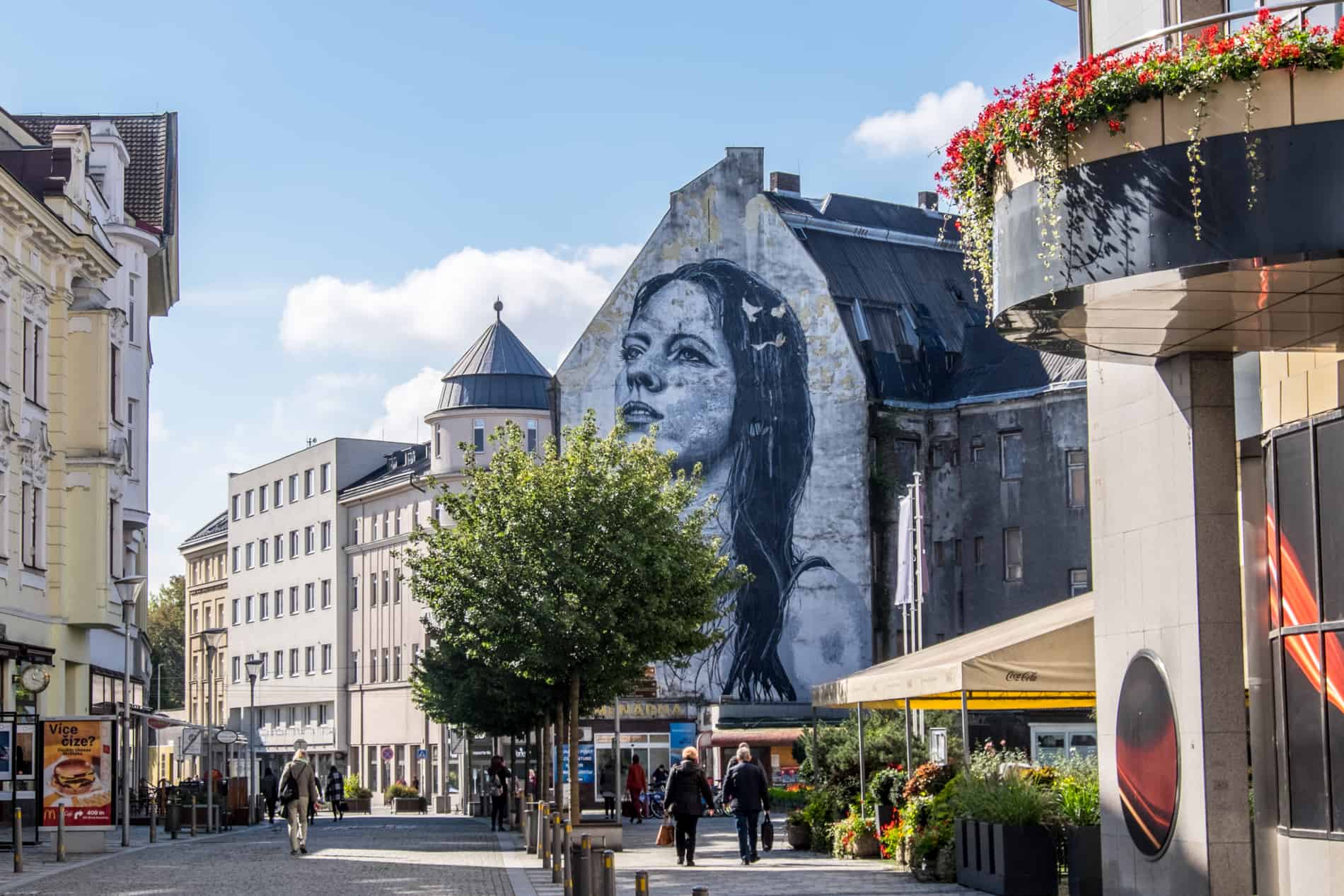
The Ostravská Madona – the symbol of the city.
Another artwork appears on a wall next to the food market – a cityscape defined by a galloping black horse by Polish artist Mariusz M-City Waras.
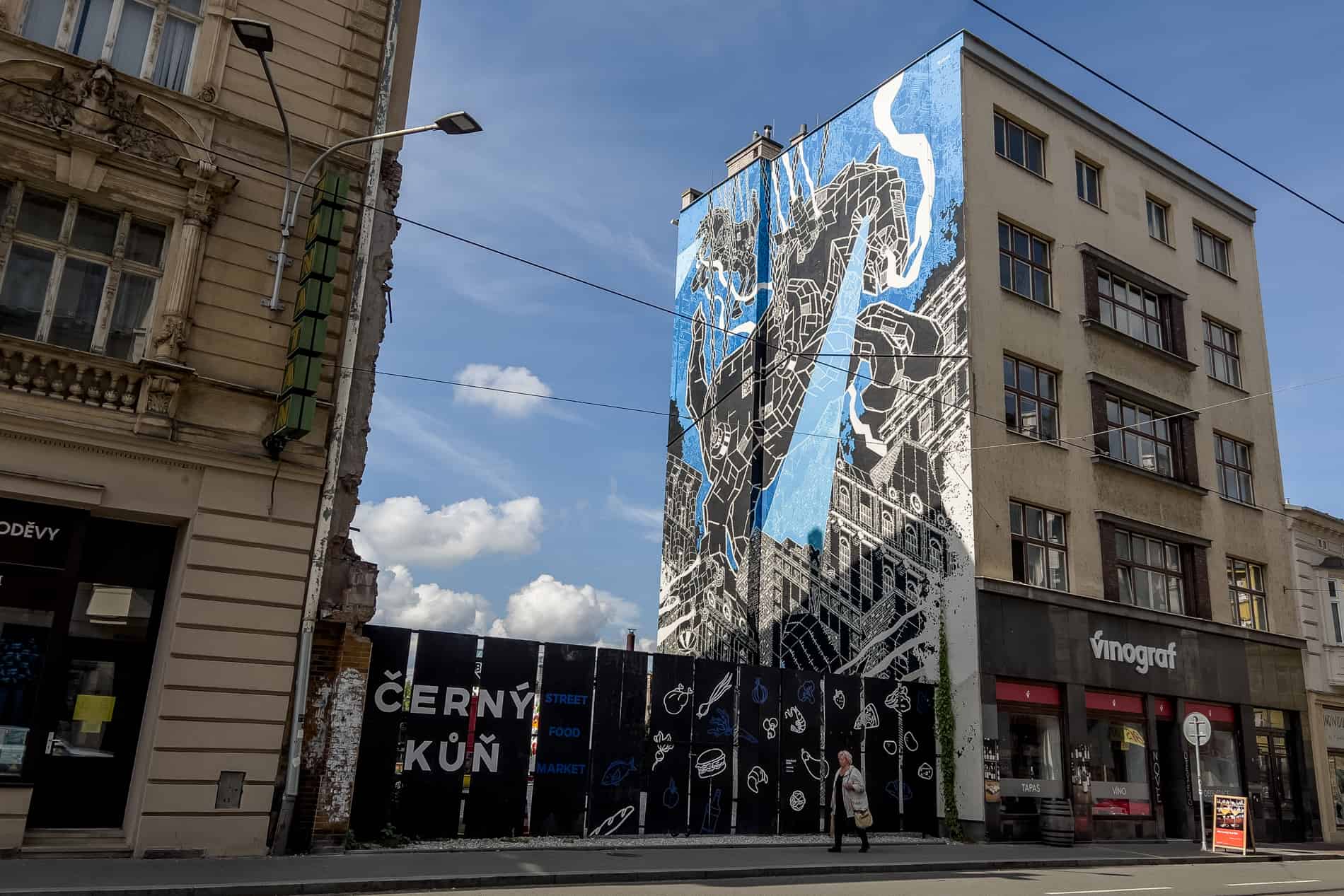
Ostrava’s black horse street art represents the rhythm of the city.
Given the history of Ostrava and its edgy artistry to bring colour to the city, it’s a perfect canvas for more street art to appear.
Gallery of Fine Arts in Ostrava
Take the largest art gallery in the region and house it in an architectural heirloom, and you’ll find a mecca of the city’s cultural revival. Ostrava’s Gallery of Fine Arts was founded in 1952 and hosts more than 23,000 masterworks in the historical red brick Functionalist building from 1926. It’s the oldest gallery in Ostrava and one of the most important in the Czech Republic. A version of Gustav Klimt’s ‘Judith’ is the pride of the gallery.
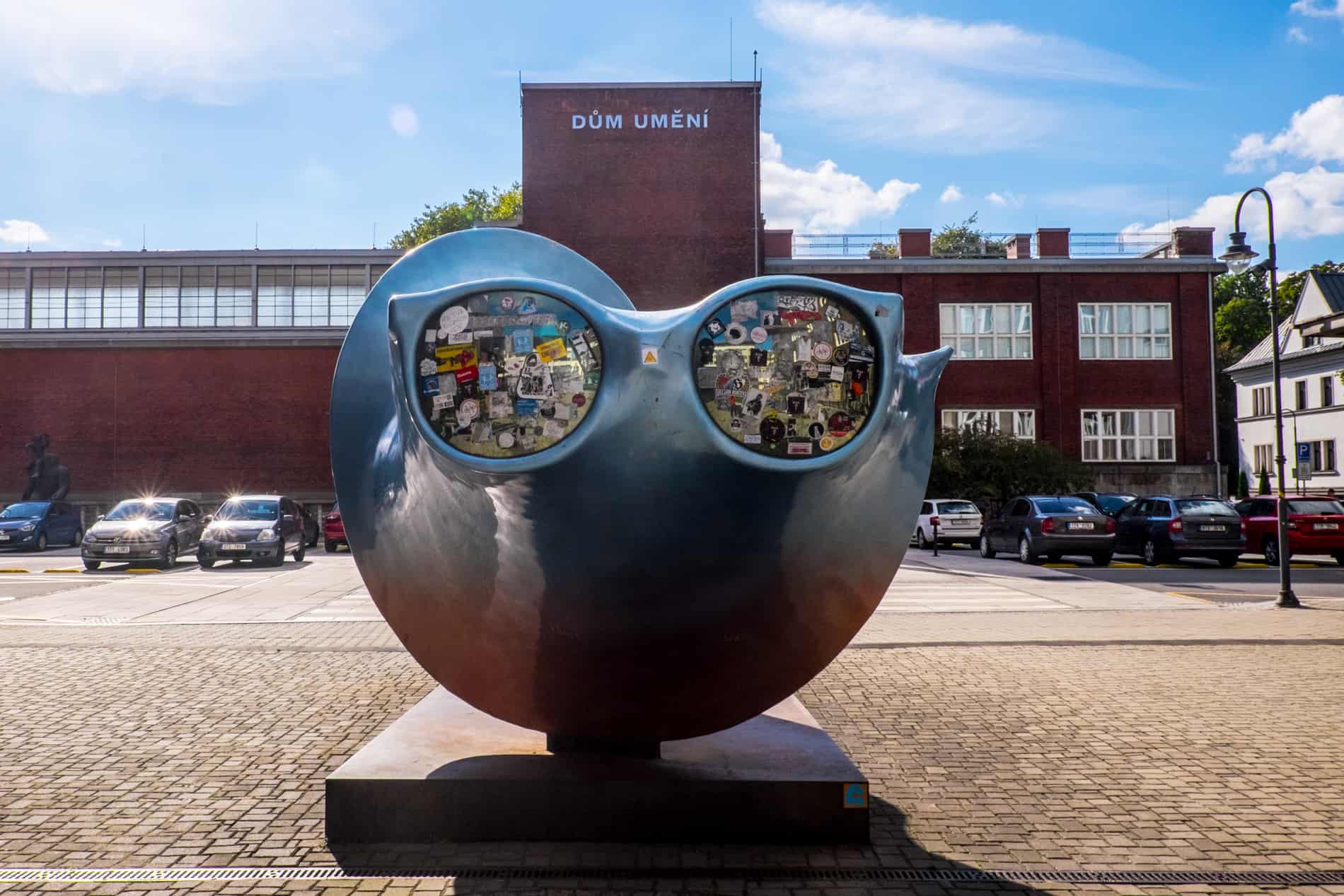
Visit the Gallery of Fine Arts in Ostrava.
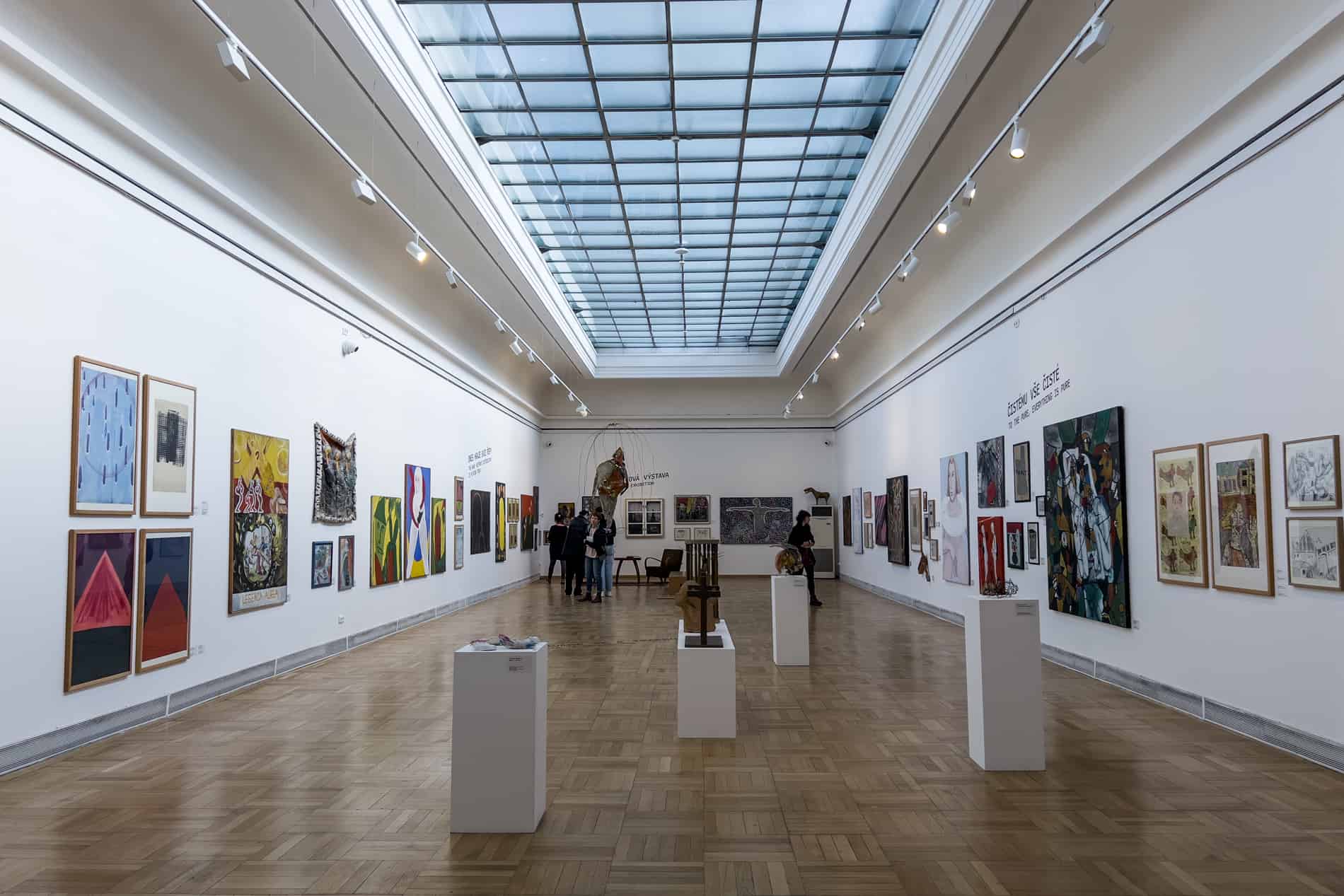
The Gallery of Fine Arts in Ostrava features the work of Czech artists across its exhibition halls.
Open: Tuesday-Sunday, 10:00 AM – 18:00 PM. Admission to all exhibitions is 100 CZK (€4).
Plato Gallery of Contemporary Art
A visual representation of ideas and the world’s complexity through materials and objects, the Plato Gallery of Contemporary Art features everything from a rusting car to model-scale looks of forthcoming architectural projects. I only saw the displays in the building that was once the former Bauhaus craft shop – the gallery is also housed in the historic and repurposed former 19th-century slaughterhouse building next door, which opened in September 2022.
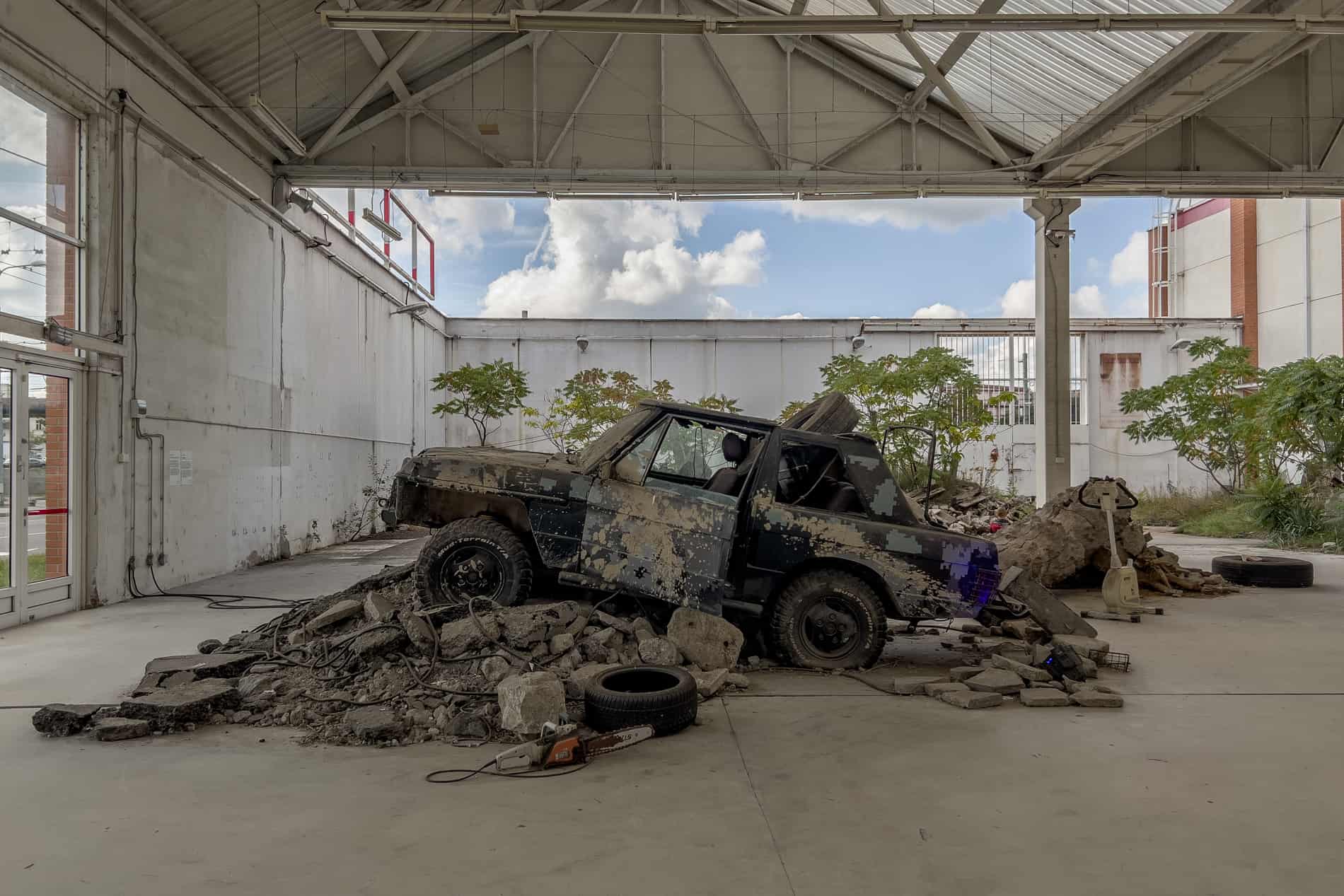
Inside the Plato Gallery of Contemporary Art at the former Bauhaus craft shop.
Open: Monday-Saturday, 11:00 AM – 18:00 PM, and late open to 20:00 PM on Thursday. Choose from three admission types, from 1 CZK to 100 CZK (€4).
Walk, Bike and Kayak the Ostravice River
Four rivers flow through the city, but Ostravice is the main tributary. Locals flock here in the warmer months, and riverside bars like Café Club Dock are busy all year round. Follow the course of the river and enjoy the green heart of Ostrava on a kayaking or river rafting trip, or walk and bike its parallel trails. Start in Komenského Sady park, heading down to cross the steel Miloš Sýkora bridge. On this side of the river, you can visit the Silesian Ostrava Castle on the way to Mound Ema. The 13th-century castle was rebuilt in 2004 after it sunk 16 metres because of mining activity.
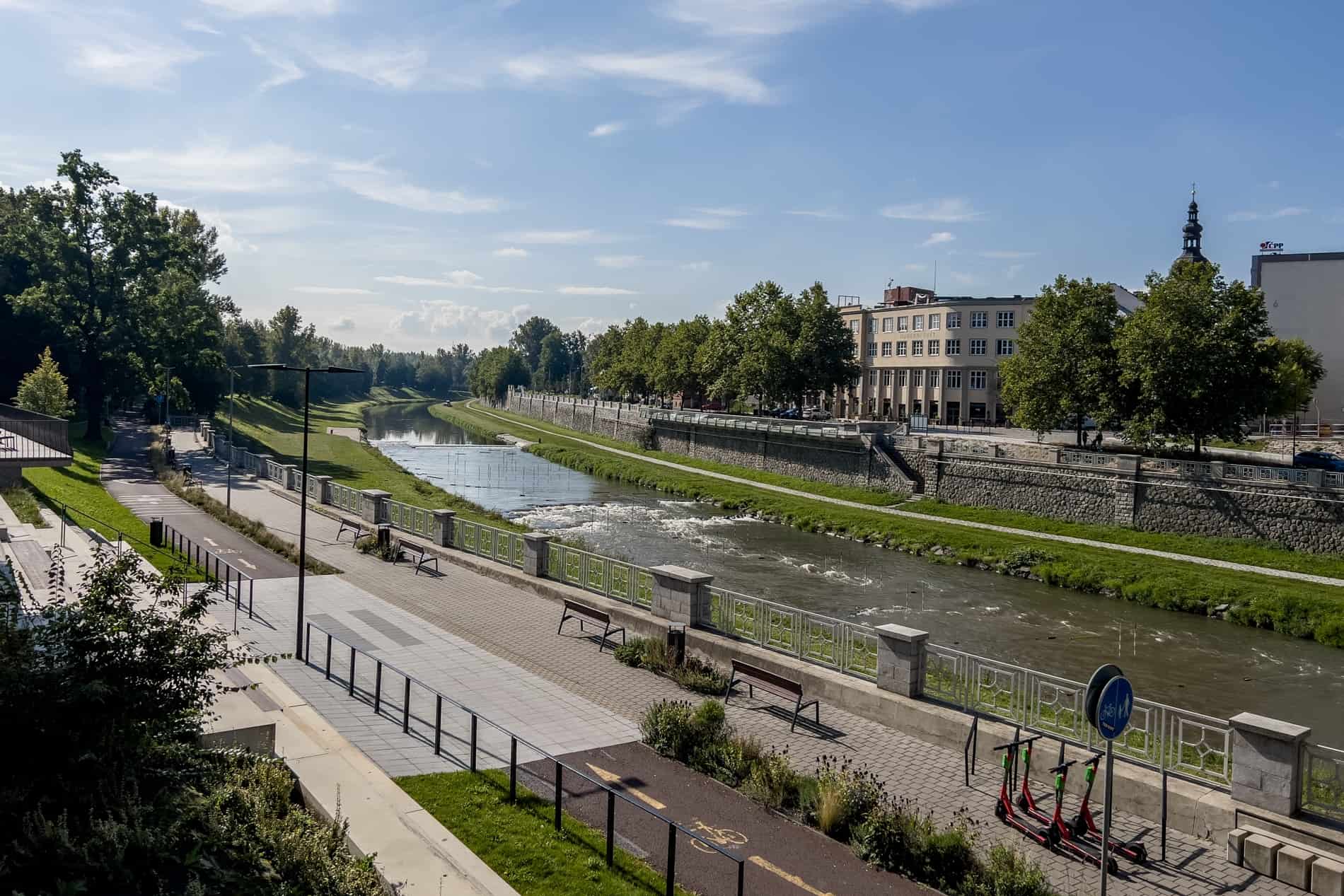
Nature in Ostrava at the Ostravice River.
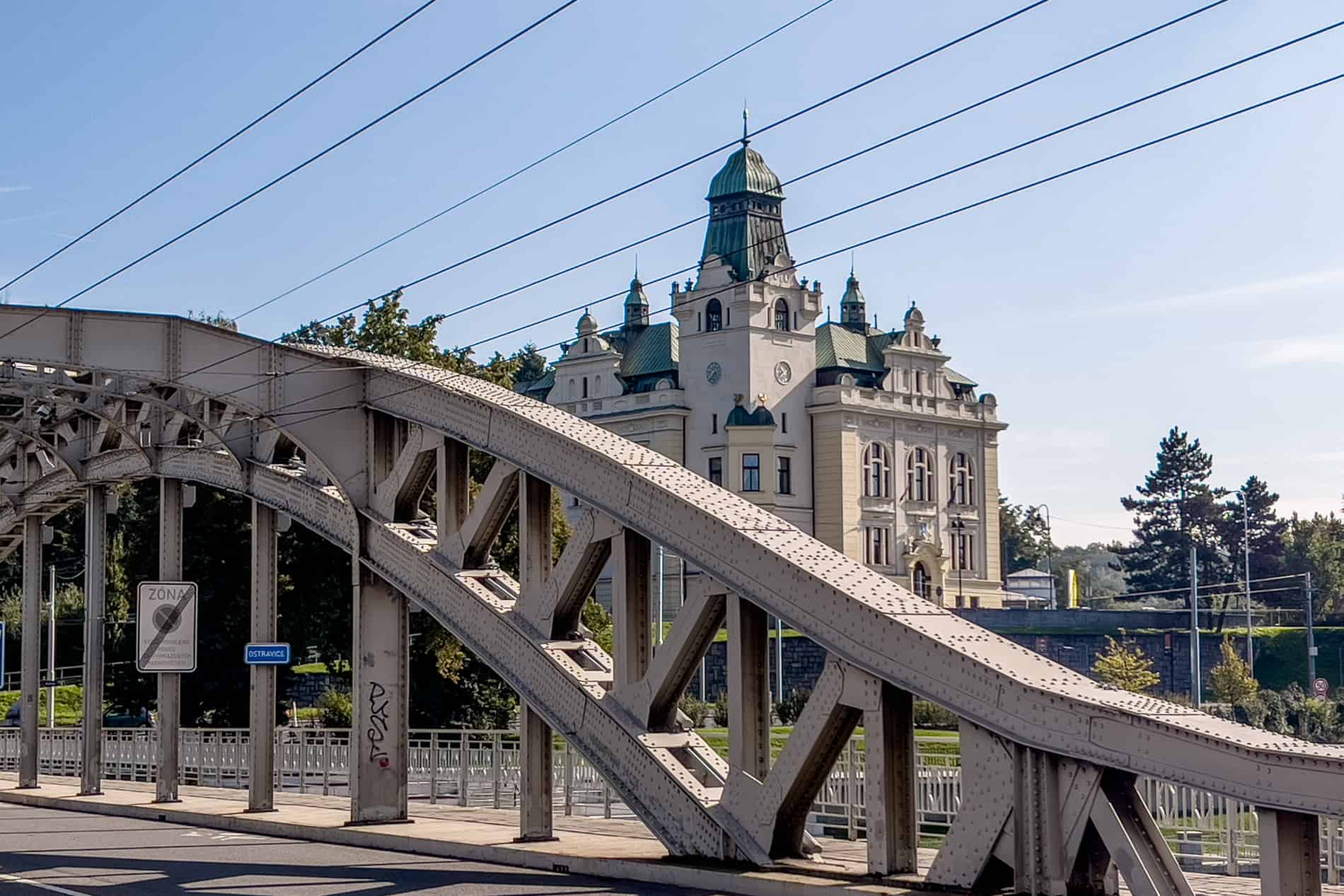
Crossing the Miloš Sýkora bridge.
The Best Viewpoints in Ostrava
Here’s where to go in Ostrava for the perfect vantage points over the city’s unique landscape.
Ostrava New City Hall Viewing Tower
One of the best views in Ostrava is from the heights of the largest and highest city hall complex in the Czech Republic, whose clock tower soars 85.6 metres high. Stand atop the New City Hall Viewing Tower for a panorama of the city from the observation deck at 73 metres. Look out across the long avenues and the Dolni Vitkovice ironworks site on its fringes. On a clear day, you can see as far as the Beskydy mountains and Poland.
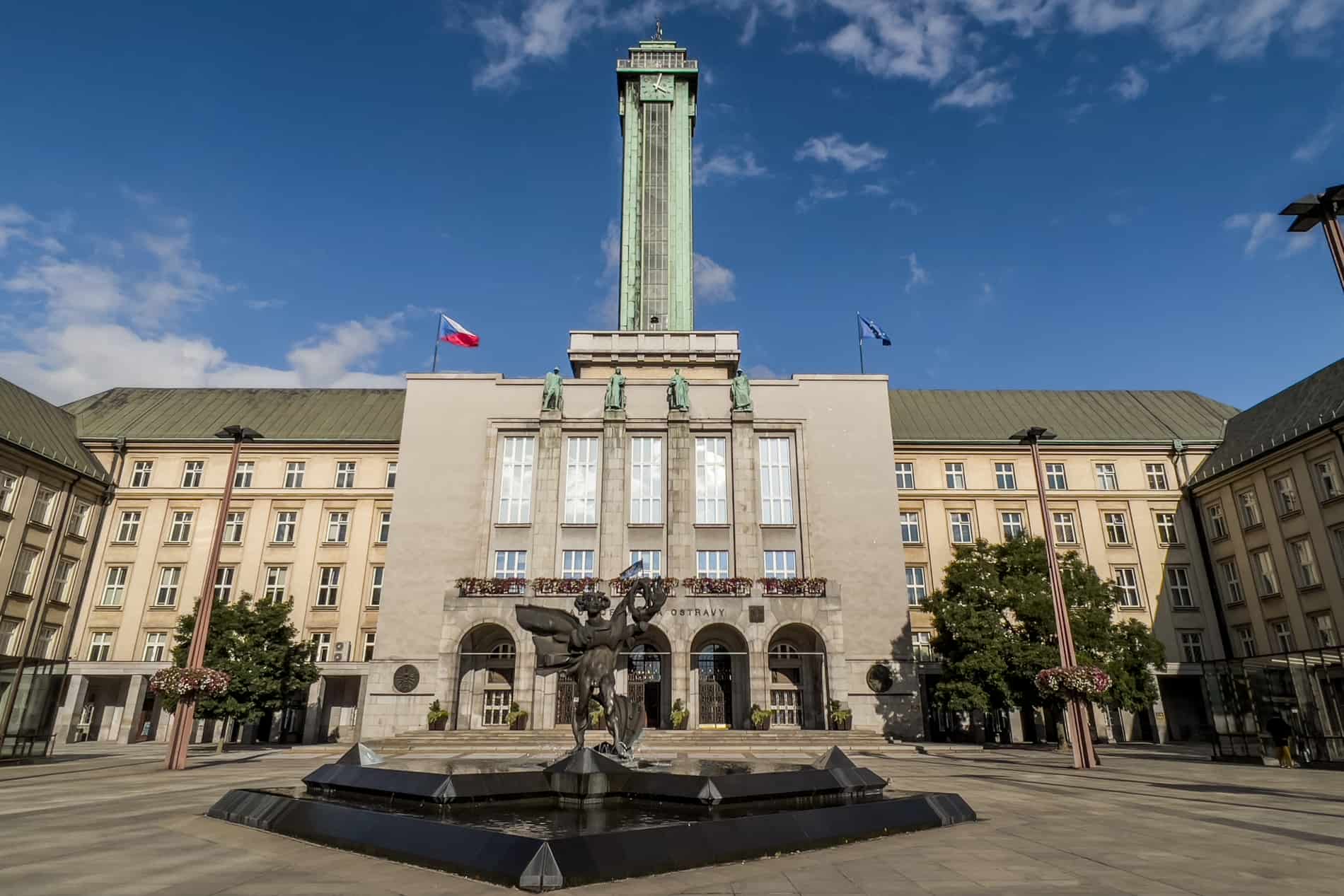
Ostrava New City Hall – the largest and highest city hall complex in the Czech Republic.
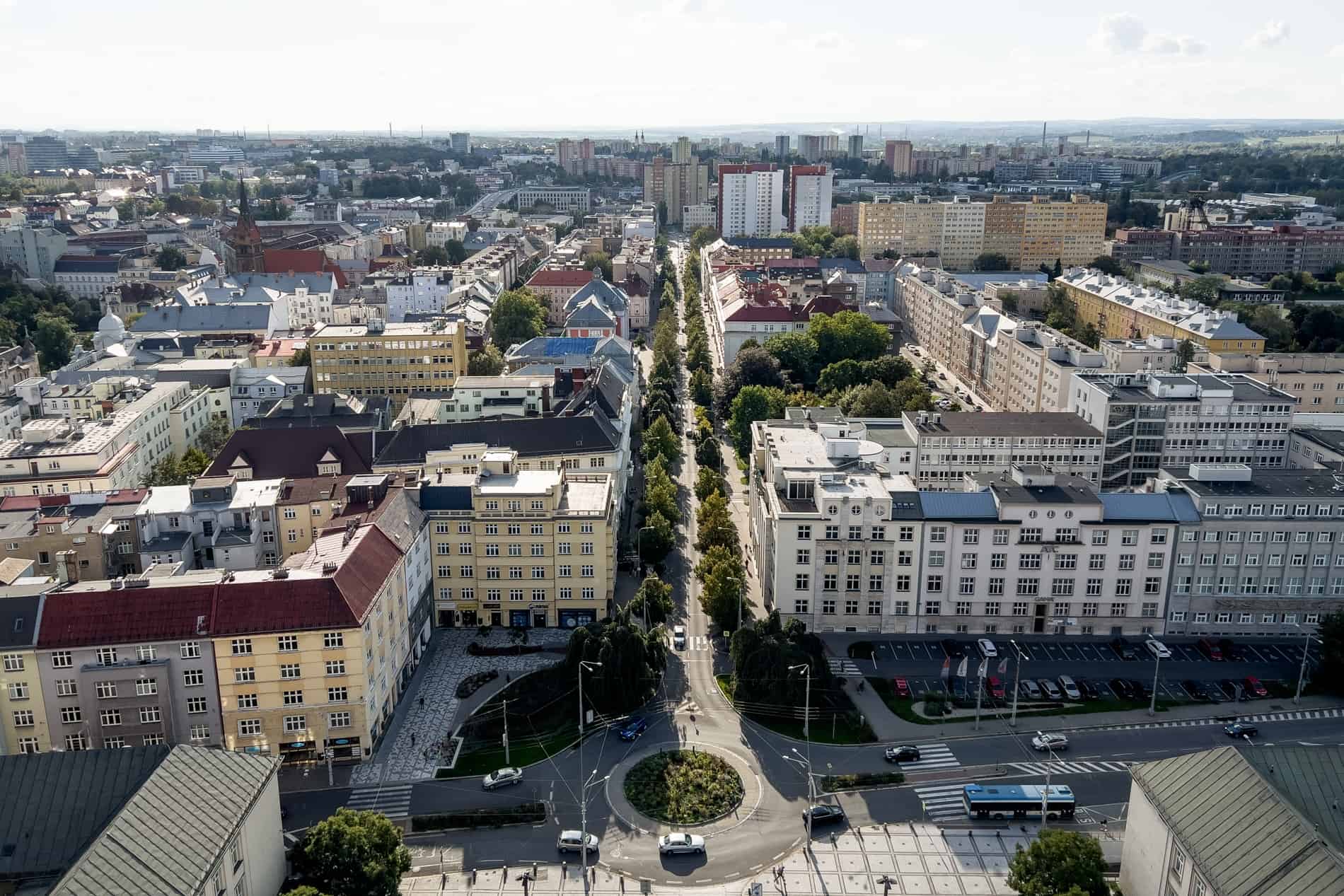
Panorama city views from the Ostrava New City Hall observation deck.
Open: Daily, March – October 9:00 AM – 19:00 PM, November – February 9:00 AM – 17:00 PM. Tickets, 60 CZK (€2.50).
Hike Ostrava’s Volcano, Mound Ema
Clamber the city’s smouldering hill at 315 metres, affectionately dubbed Ostrava’s Volcano or Ostrava’s Mount Vesuvius. The name is in jest – the man-made smoking slag heap of Mound Ema was formed from a pile-up of 28 million tons of still active waste material from an old coal mine that was heated to extract the metal. It continues to burn deep underground.
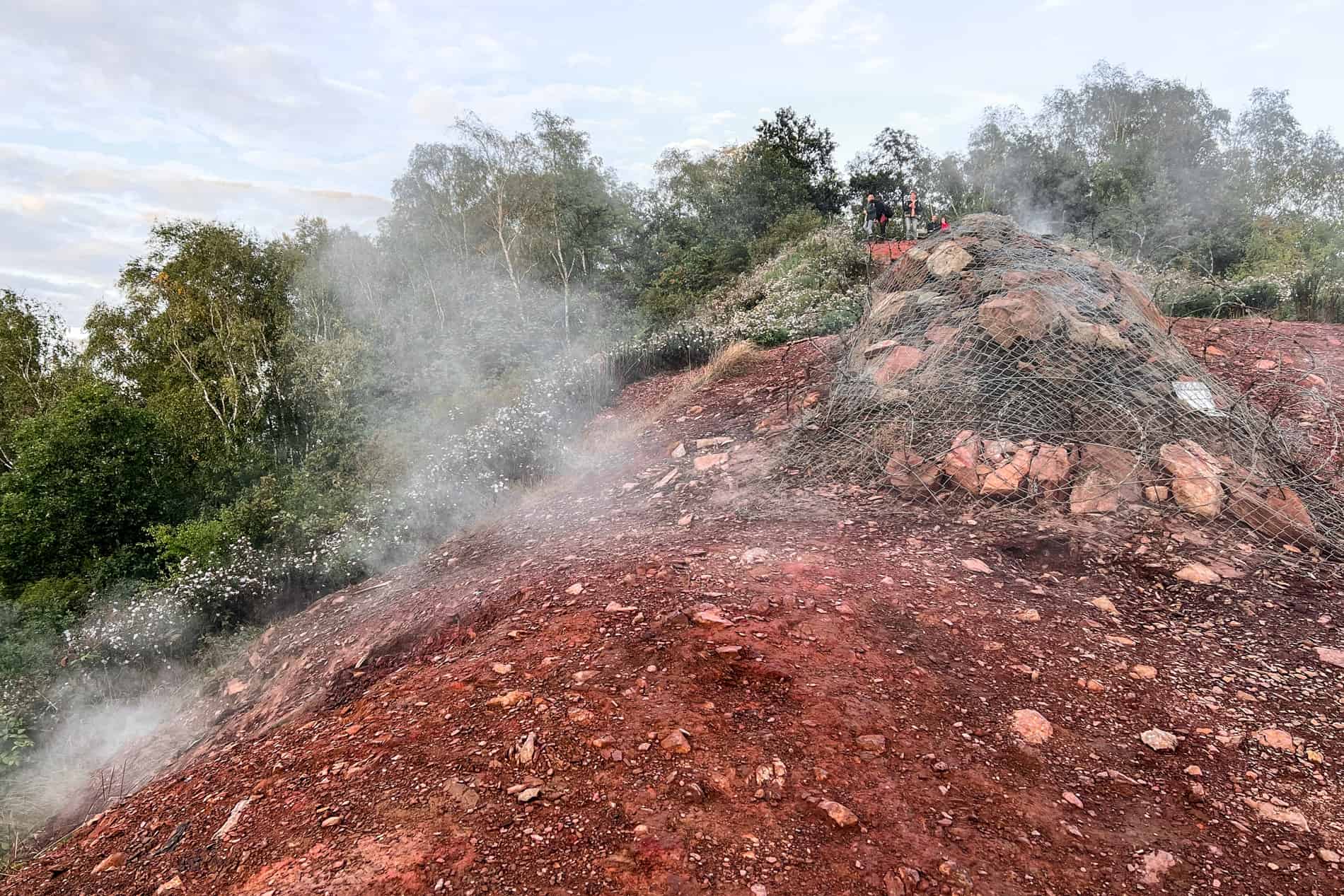
The still-smoking Mound Ema slag heap.
The mound’s light fumes and sulphuric stench don’t stop people from visiting Mound Ema for a prime viewpoint over Ostrava, especially at sunset. To get there, cross the Miloš Sýkora bridge to the eastern side of the river and follow the yellow hiking trails on a 30-minute adventure.
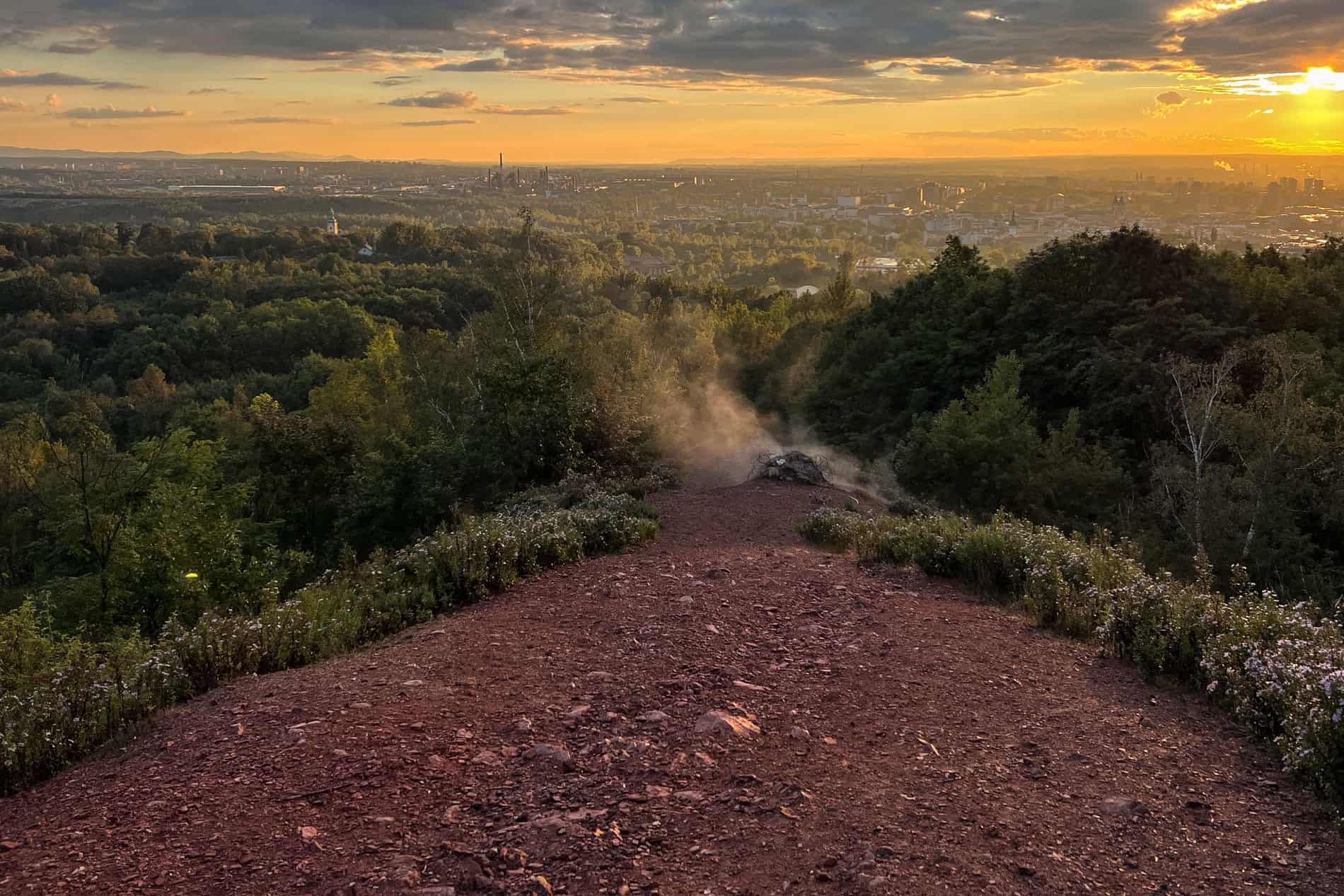
Climb Mound Ema for sunset.
The Bolt Tower – Ostrava’s Highest Geographical Point
At the Dolní Vítkovice former ironworks, head up the skip lift to the top of Furnace No. 1 for the viewing platform and café of the Bolt Tower. Built upon the former iron blast furnace site, the protruding glass layers were designed to resemble fire.
It’s the highest point in Ostrava at 78 meters, dominating the skyline of Ostrava with a new perspective over the city. It’s named after Usain Bolt, who inaugurated the site in May 2015, a regular visitor in Ostrava for the annual Golden Spike athletics event.
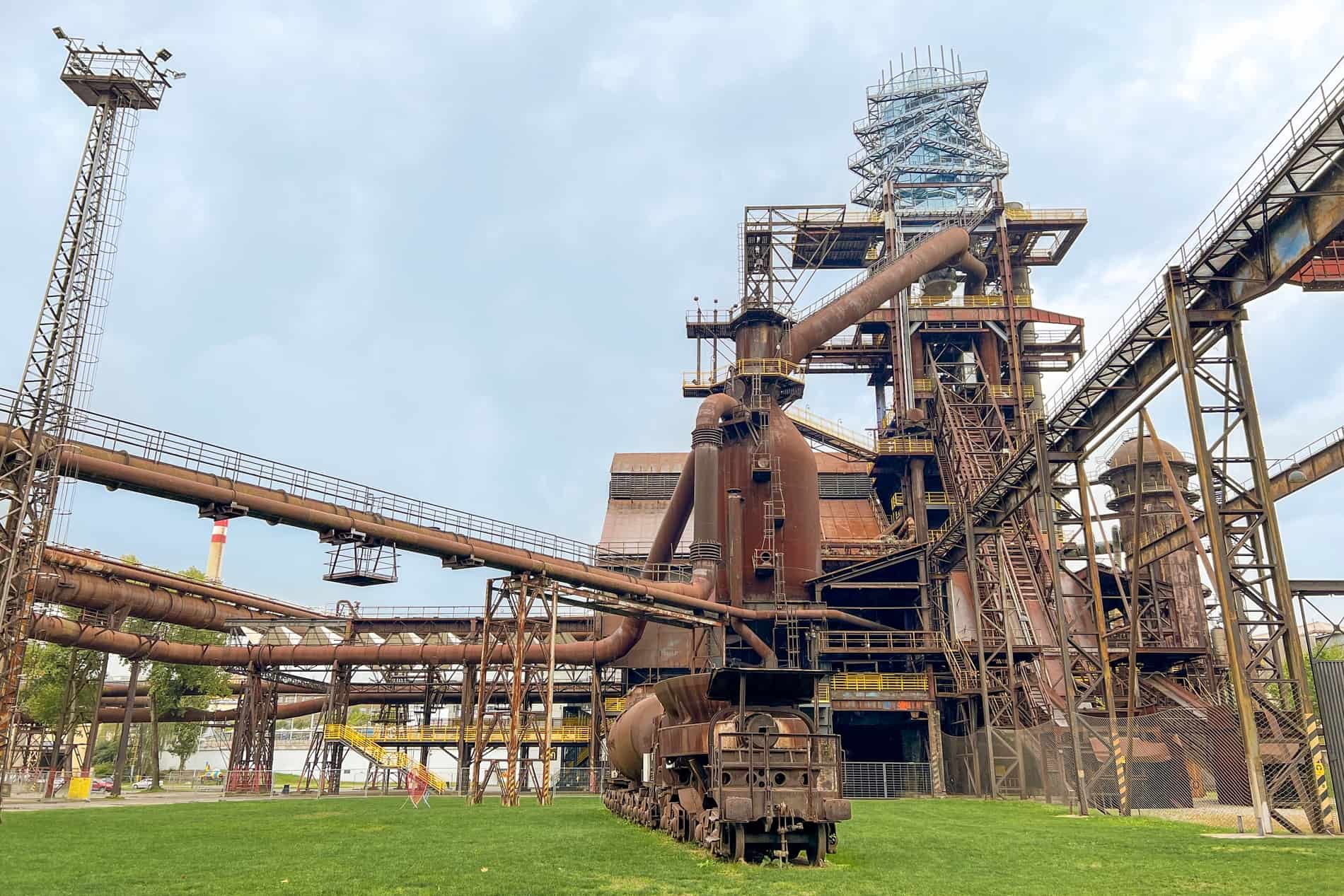
The glass Bolt Tower at Dolní Vítkovice.
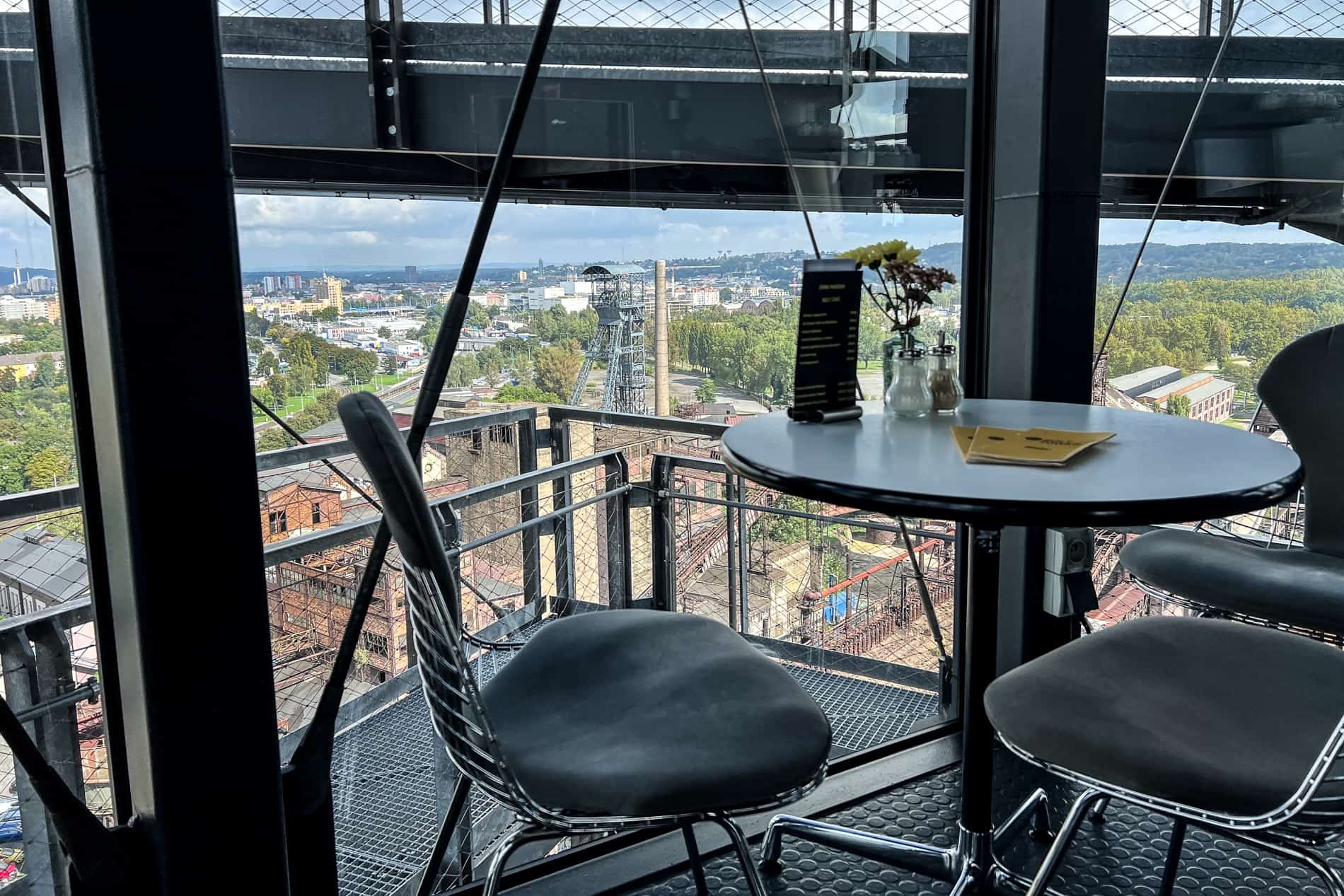
Views from the bolt Tower cafe and platform over the vast Dolní Vítkovice site.
Open: Monday-Sunday 10:00 AM – 18:00 PM. A reservation is required to visit the Bolt Tower, which you can book online. Entry is 200 CZK (€8), which includes access to the café.
Things to Do in Ostrava – Repurposed Mining Relics
Ostrava’s underground city monuments remember its heritage and its people. While closing the mines was great for the environment, it also left behind an unemployed generation of people. Repurposing the sites for educational tourism helped turn that around, with some site tours run by former miners and rescuers.
Dolní Vitkovice – Ostrava’s Former Ironworks Site
In the outer city quarter of Vitkovice stands a mesh of stacked red brick structures, jutting smokestacks and snaking pipelines, bridges, and blast furnaces – the remainder of the former ironworks of Dolní Vitkovice where coal was mined and iron was forged between 1828-1998. It’s now a landmark of Ostrava, repurposed into one of the city’s top attractions.
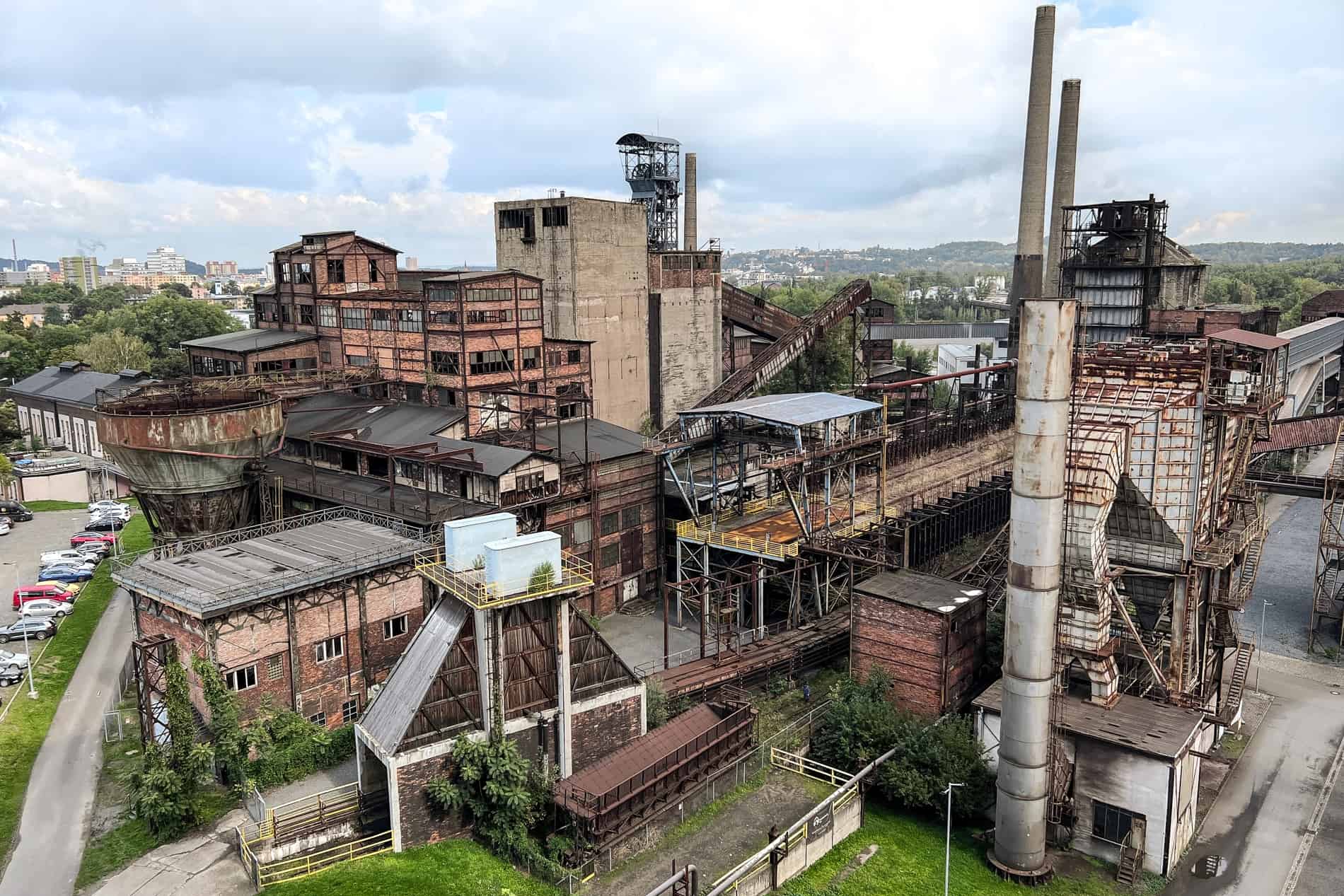
Dolní Vitkovice – Ostrava former ironworks was the city’s first major industry site.
You wouldn’t know from a distance that this site has been reinvigorated into a cultural centre that’s filled its empty spaces. Alongside site tours and the Bolt Tower viewing platform, there’s a climbing wall in the place of a former mine, the interactive Svet Techniky (Science and Technology) Museum in a hanger building, a concert auditorium in the former gas collector, and the Heligonka cabaret club and Etaz cinema in the old worker’s buildings.
Every July, the site becomes a pumping festival ground for the international music festival, Colours of Ostrava – the largest festival in the country.
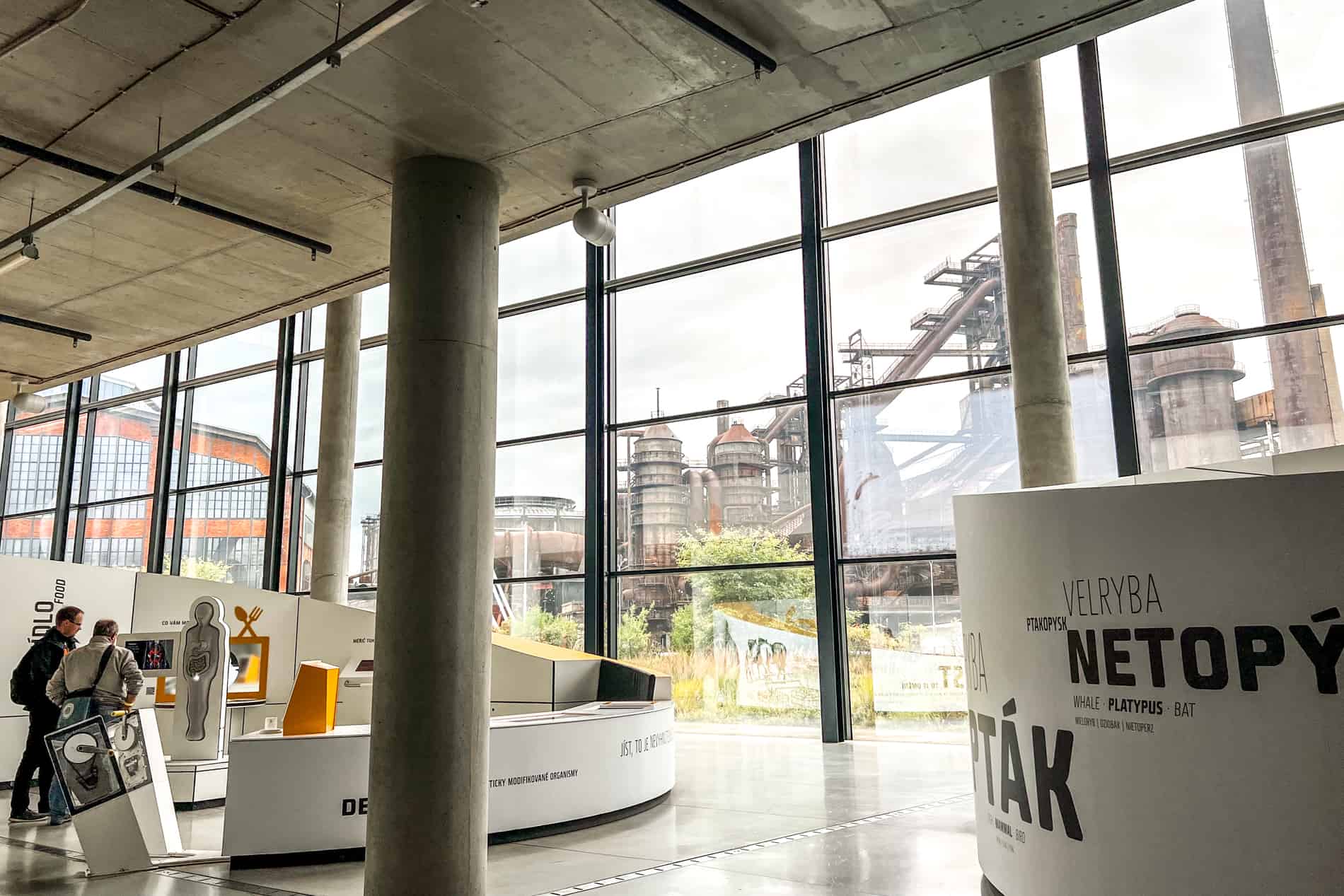
Svet Techniky (Science and Technology) Museum in a repurposed industrial building.
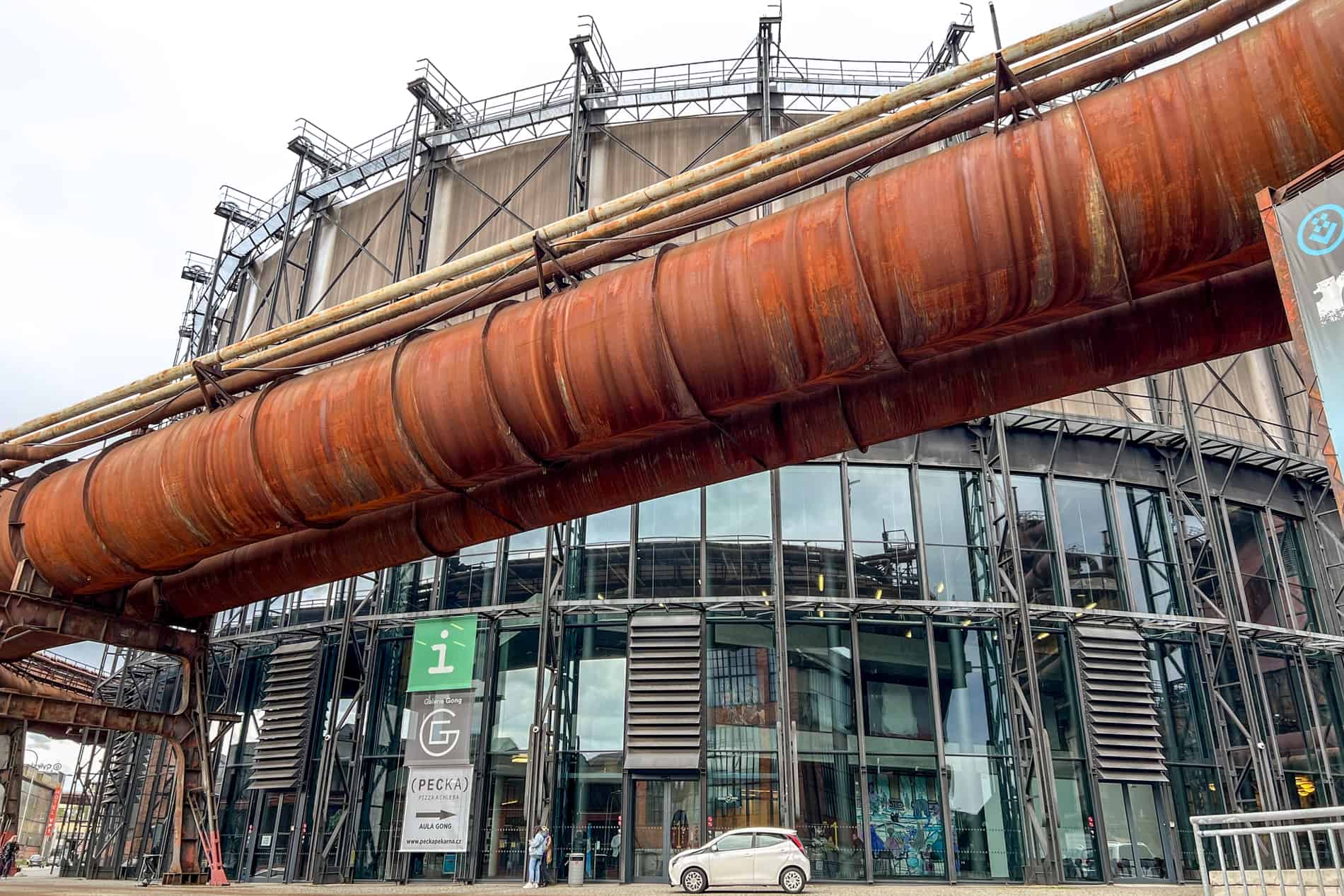
The Galerie Gong live music venue at Dolní Vitkovice.
Get there: Tram 1, stop at Dolni Vitkovice. Tram 2, stop at Dolni Vitkovice Hlubina.
Tours: Reserved time slot tickets are required for the site tours, from 250 CZK (€10).
Landek Park Mine Museum – Go Into a Shaft
North of the city centre on the nature reserve of Landek Hill is the site of Landek Park – the only place in Ostrava where you can go down into the shafts of the former mine of Anselm. Entering via the original mining cage, walk through 250 metres of underground corridors of the oldest mine in Ostrava, learning about the daily grind of the miners and the machinery used. With its incorporated mining rescue museum, Landek Park is the largest mining museum in the Czech Republic.
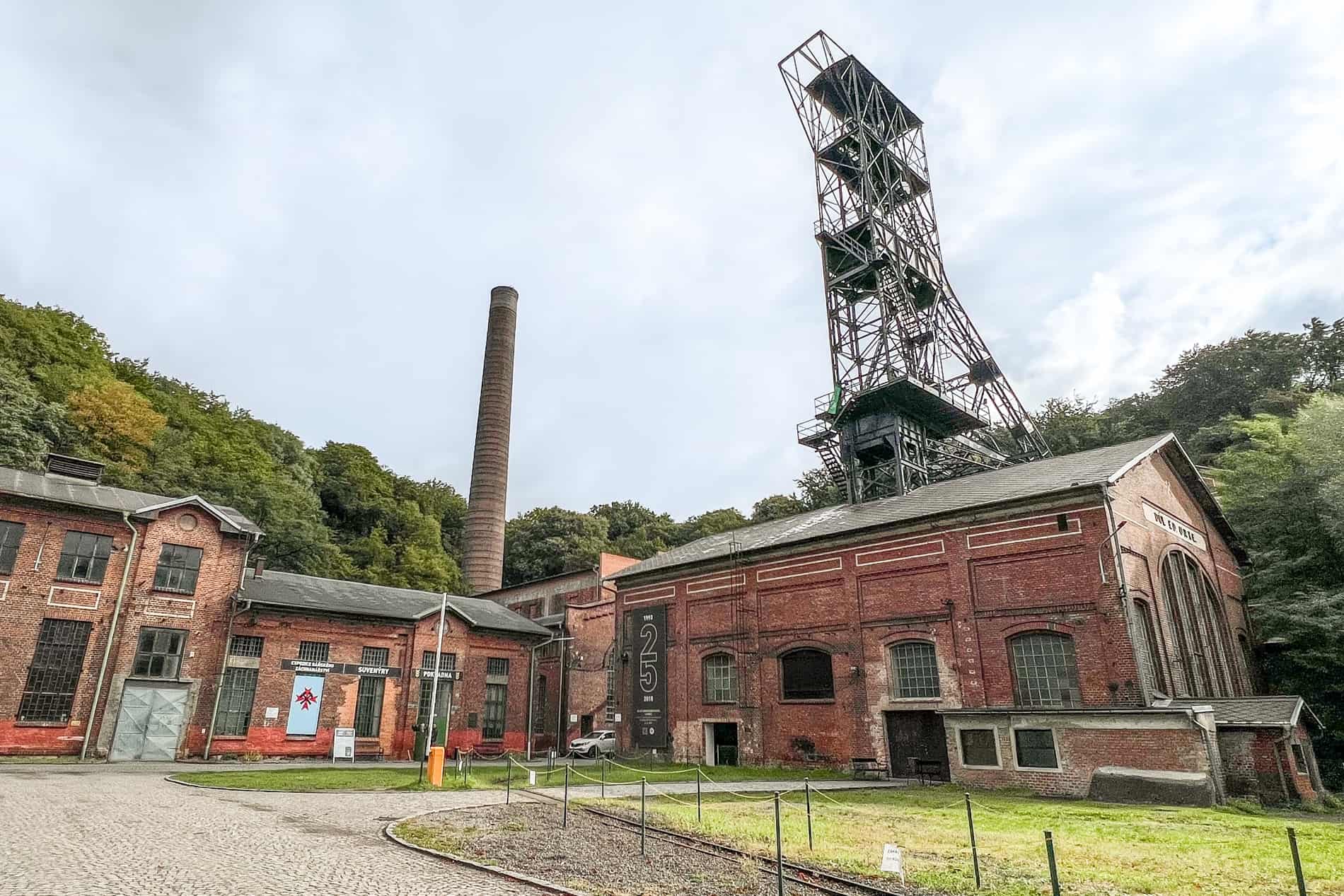
Landek Park Mine Museum, Ostrava
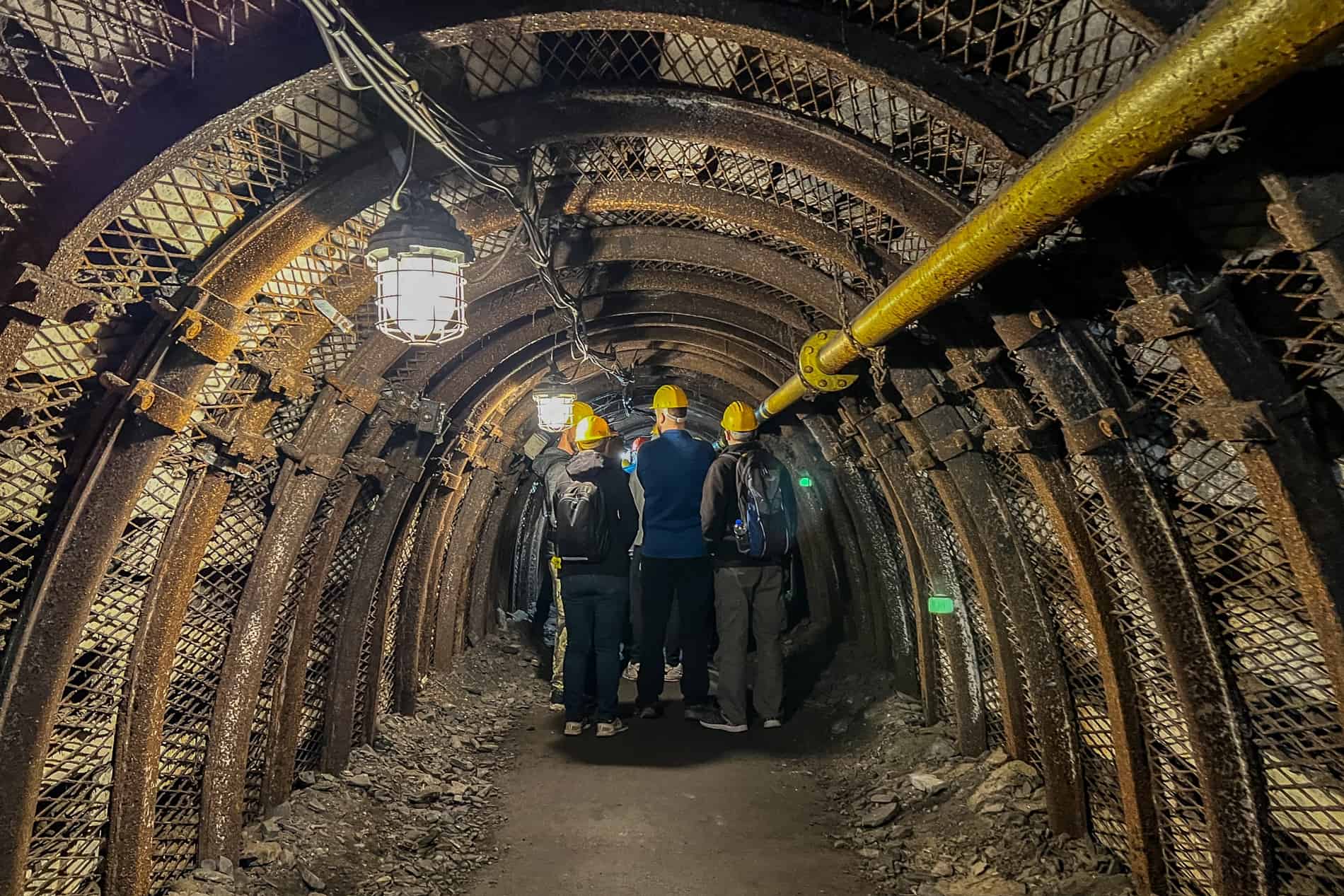
Mining history up close – one of the more uncommon things to do in Ostrava.
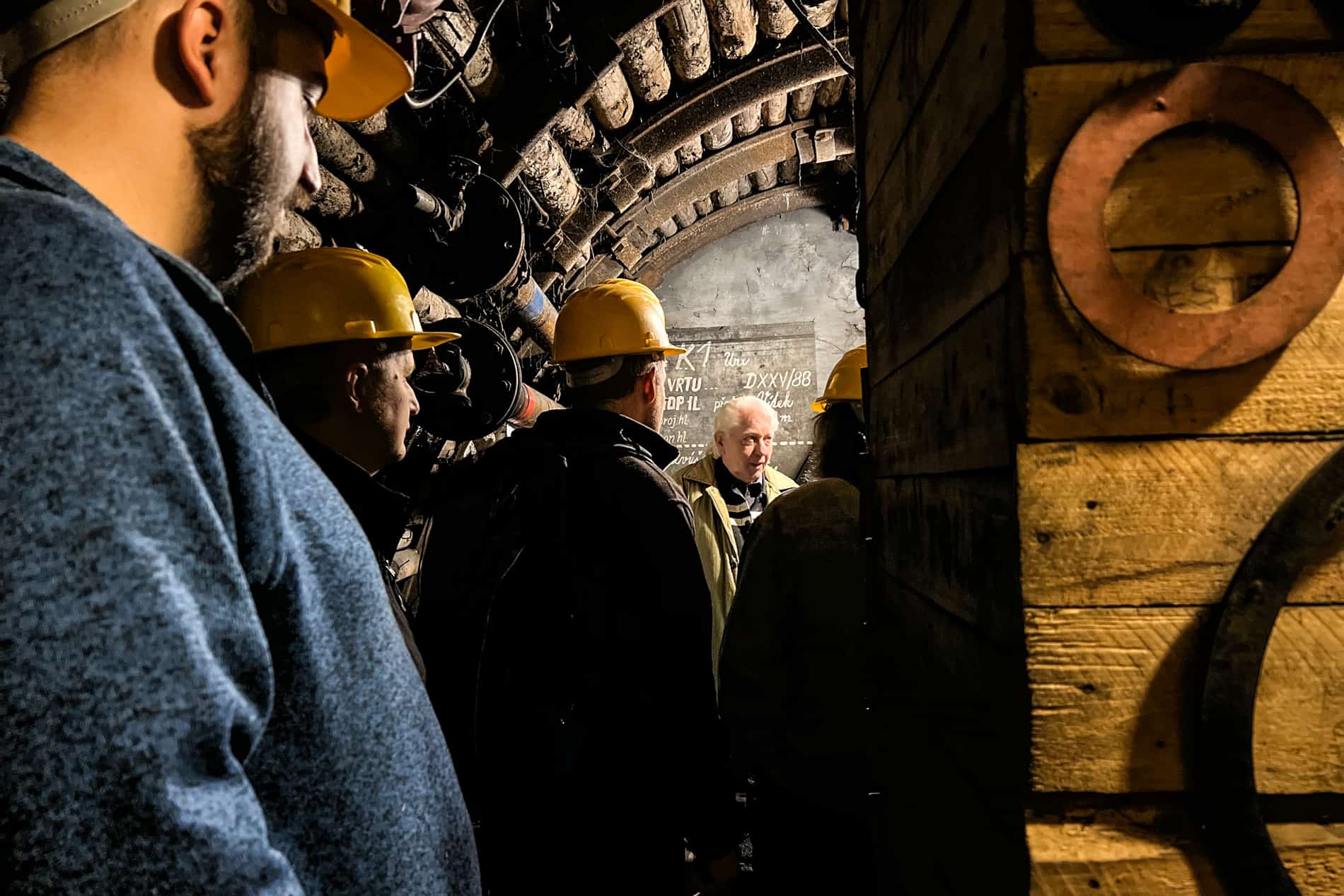
Take a tour of the shafts of the former mine of Anselm.
Get there: Bus 34, 52, 56, 66, 67, 68, stop at Hornické Muzeum.
Tours: Open year-round, tours run Monday-Sunday, 9:00 am – 18:00 pm, starting on the hour. Admission is 220 CZ (€9).
Michal Coalmine – As It Was Left
At the former Michal coalmine site in Michálkovice east of Ostrava’s centre, this preserved site is a time capsule of when the last miners went home on 2nd June 1994. On the “Miner’s Journey to Work” tour” see the dressing rooms and offices, engine halls and boiler rooms, and even the miner’s Pub – this national cultural monument keeps everything as it was in the original condition from 1912 – 1915.
Get there: Bus 23, 49, 97, or Trolley 104, stop at Michálkovice.
Tours: Only open April-October. Admission is 110 CZK (€4.50).
Poruba – Communist Era Worker’s District
The western neighbourhood of Poruba is known for its architecture of socialist realism by architect Lakomy, a style called Sorela. It intended to glorify the mining industry and represent the perfect communist working family. Gargantuan apartments buildings line the main boulevard of Hlavni Trida – the former Leninka (Lenin Avenue) – but the showpiece, at the end of Porubská street, is the semi-circular residential behemoth with its hammer and sickle-topped triumphal arch. It was kept as a historical monument while today’s trendy Poruba grows around it.
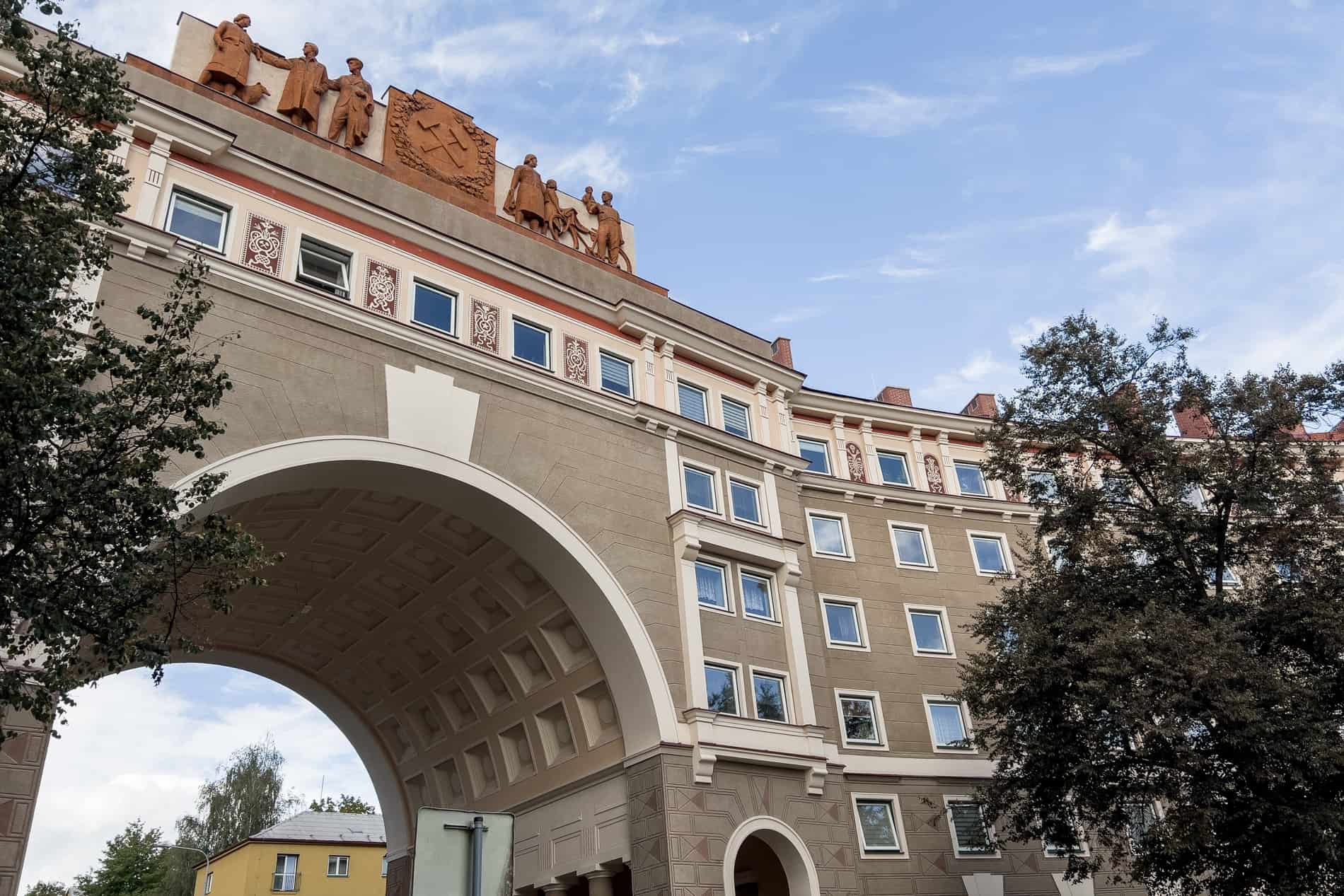
The architecture of socialist realism in Poruba, Ostrava.
Culinary and Café Culture in Ostrava
From morning until night, coffee to cuisine, there’s enough choice in Ostrava to keep you fuelled.
The Best Coffee Shops in Ostrava
Café culture is a firm fixture of Ostrava’s social scene, and with so many third-wave coffee shops and cafes with character, you’ll unlikely get through them all on a single visit. U Černého Stromu (Black Tree Café) opposite the New City Hall is a hip hangout, but Nádražni street is the avenue of coffee. PetPunk, Shothouse, Kafekrámek Čerstvý Boby (Fresh Beans) and CØKAFE are known for robust espresso and batch brews using beans from local roasters, and Kavarna Daniel adds a little timeworn quirk with its old apartment setting.
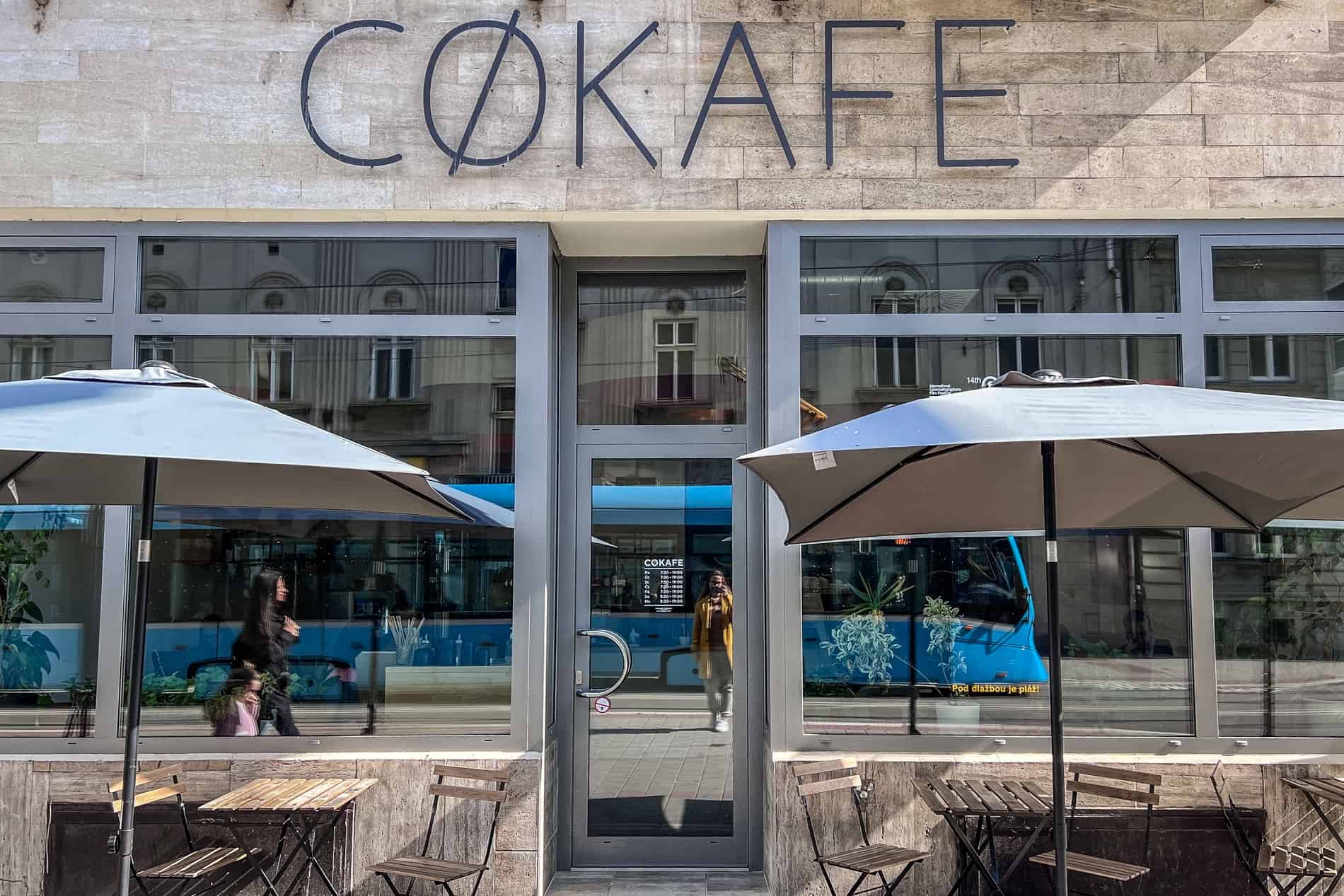
Ostrava is perfect for coffee enthusiasts.
Where to Eat in Ostrava
Ostrava is where you can support independent businesses, with locally run bistros leading the charge. Hogo Fogo is the most famous and revered, set in a historic red brick house, and offers a menu based on seasonal ingredients. La Petite Conversation bistro is run by a Belgian native, bringing a touch of home to the menu.
For food truck bites, head to Černý kůň (Black Horse) street food market with vendors from the Moravian-Silesian region. Frankie’s Pub is the new kid on the block – an American steak joint serving meat feasts with a fresh Pilsner Urquell tank beer pour. Burfi is the vegetarian pick, and there’s an extensive Vegan offering at Forky’s. For sandwich snacks made with local products, get yourself to Milk Bar Naproti.
Nightlife in Ostrava Beyond Stoldoni Street
A former lane of slaughterhouses turned party avenue of bars, pubs, and dive clubs, Stoldoni Street makes every list of things to do in Ostrava. It’s rowdy, rough around the edges, and not necessarily a vibe for everyone. However, establishments like the Modrá myš cocktail bar add a touch of elegance, continuing the traditions of the former Blaue Maus American bar that closed in 1925.
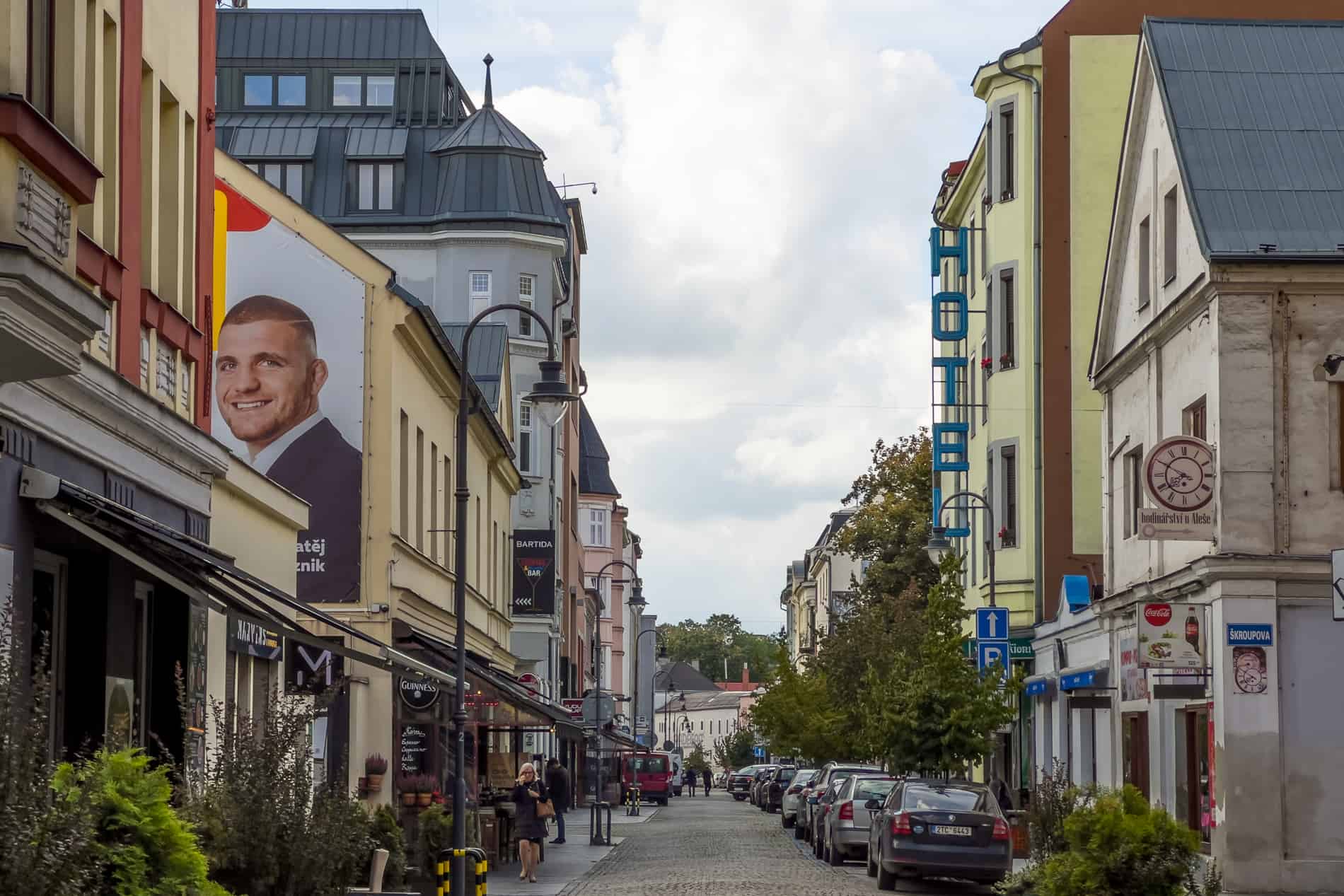
Ostrava’s nightlife is not just limited to Stoldoni Street.
I much preferred Café Club dock on the embankment, which regularly hosts live music gigs, or to take the chance to try Moravian wines in bars like Vinograf, Hokus Pokus and Wine Cellar Near the Bridge. Moravia is known primarily for its white wines, with the lesser-known Palava grape variety being one of my top recommendations.
Day Trips From Ostrava
They say the best time to visit Ostrava is in the week as the locals take off to North Moravia’s Beskydy and Jeseníky mountains on the weekends.
Karlova Studánka, Jeseníky Mountains
A 2.5-hour journey northwest of Ostrava lands you in the natural paradise of the Jeseníky mountains and the spa town of Karlova Studánka, where you can hike the Bílá Opava – one of the most beautiful trails in the peaks of North Moravia. You can get there by the Arriva bus service.
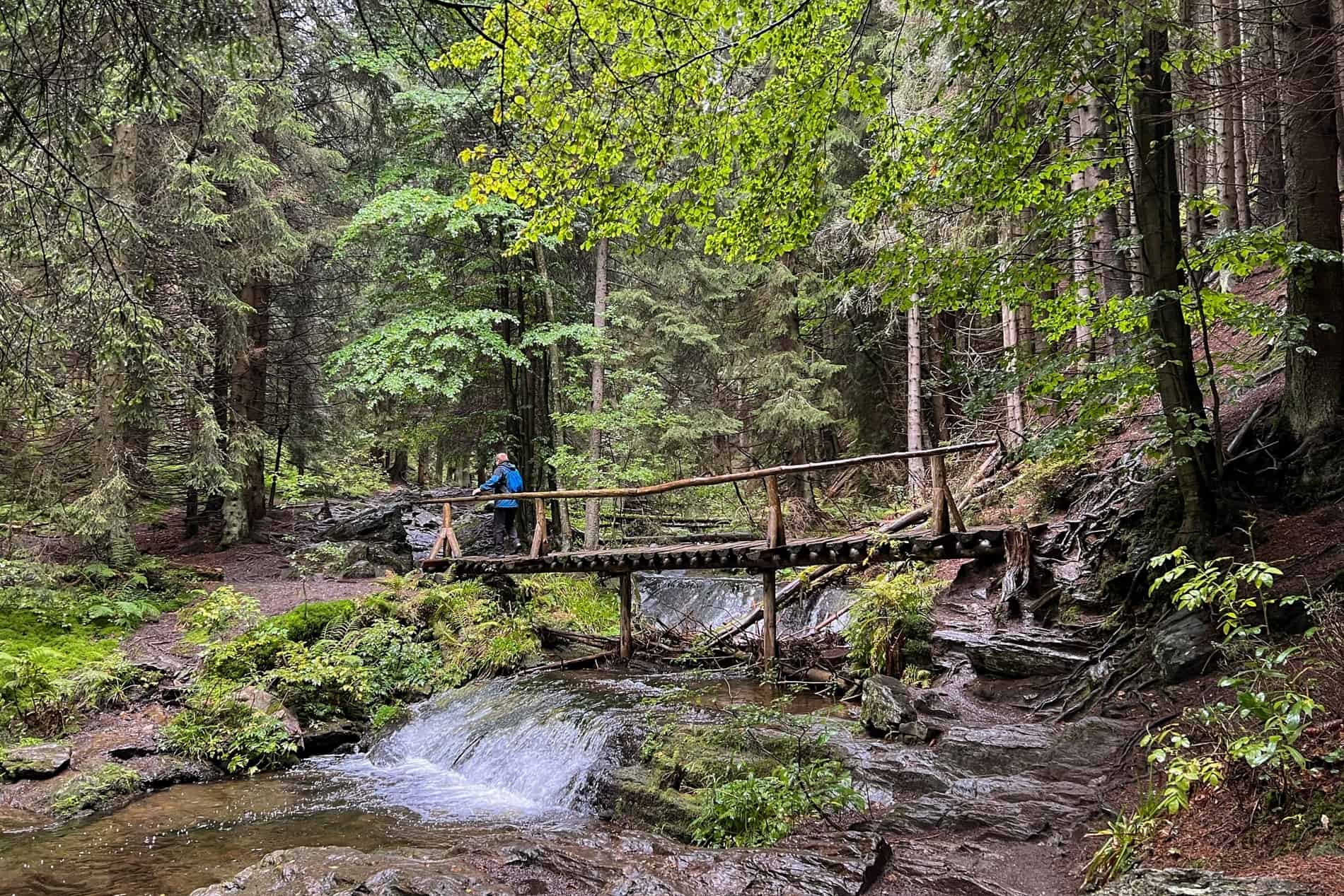
The Bílá Opava trail in the Jeseníky mountains, not far from Ostrava.
Štramberk, Beskydy Mountains
1.5 hours south of Ostrava is the protected historical town of Štramberk which unfurls at the foot of the Beskydy Mountains, famous for the ‘Štramberk Ears’ baked gingerbread treat. You can take a Czech Railways (ČD) train there.
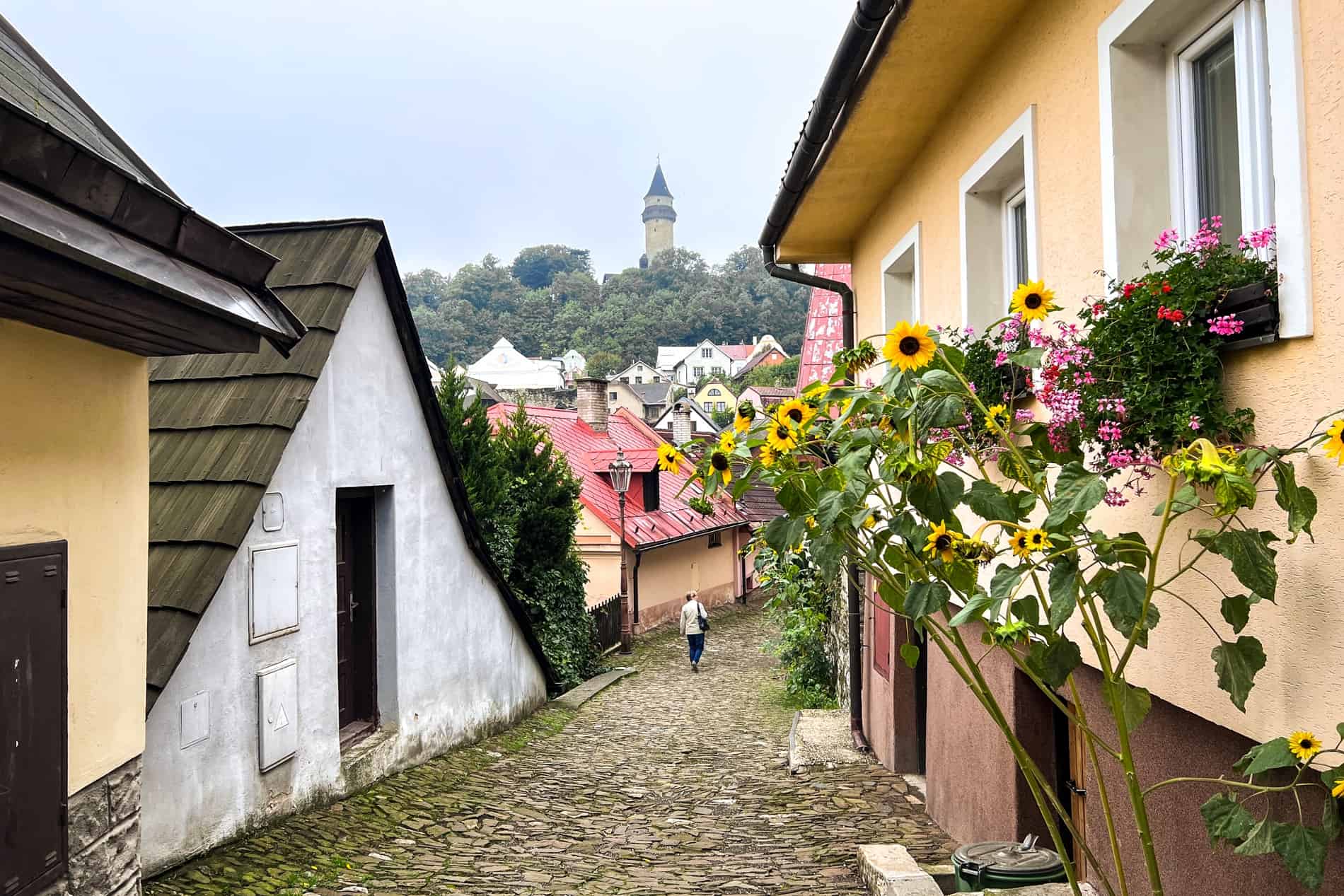
Day trip to Štramberk in the Beskydy Mountains.
City-hopping, Brno
Combining Ostrava with Brno? Underground labyrinths, unique sculptures, bunkers and secret bars fill the Czech Republic’s second-largest city. Read my article about all the unusual things to do in Brno.
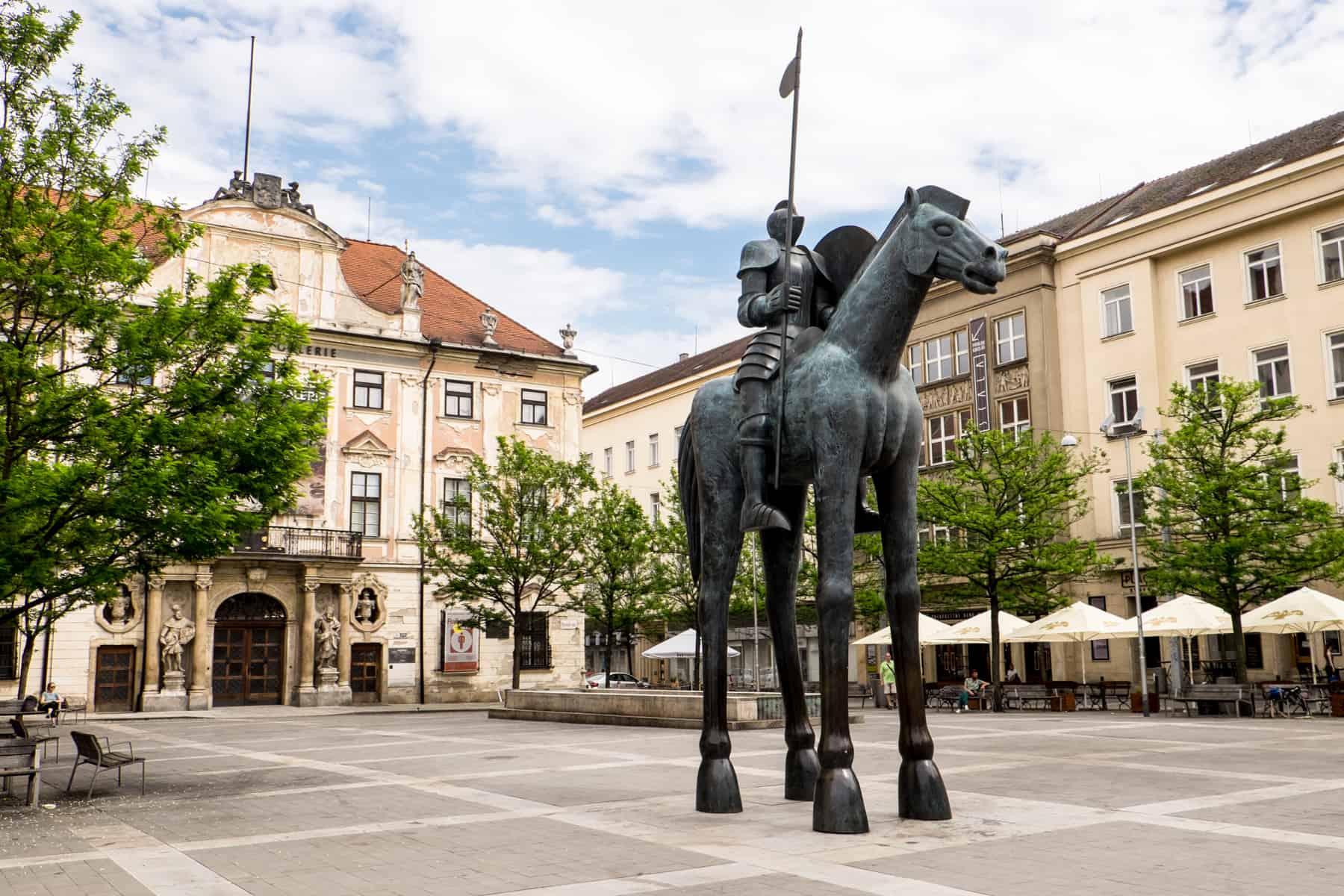
City hop – Brno is two hours from Ostrava.
Travel to Ostrava, Czech Republic – Practical Tips
Intrigued by this underrated city? Here’s how to plan your trip to Ostrava
How to get to Ostrava
With plenty of public transport connections, it’s easy to get to Ostrava from neighbouring cities and other European capitals.
Bus to Ostrava
Flixbus and RegioJet have services to Ostrava from Prague and Vienna, passing through Brno and Olomouc. Services also connect Ostrava to cities in Poland, including Kraków and Warsaw.
Train to Ostrava
Ostrava has two train stations – Hlavní nádraží (the main station) and Ostrava-Svinov, both connecting to outer Ostrava, Czech and neighbouring European cities.
Check times and ticket prices for trains and buses:
- From Vienna to Ostrava
- From Brno to Ostrava
- From Prague to Ostrava
Fly to Ostrava
Leoš Janáček Airport Ostrava is an International Airport 25km from the centre, reachable by the S4 train line. Ryanair flies between London Stansted and Ostrava.
Getting Around
Ostrava city centre is walkable, but you can also use the public transport network to access the surrounding areas such as Dolni Vitkovice and Poruba. Look out for the turquoise buses, trams, and trolleys. You can use contactless payment – tap your card on the yellow terminals next door or download the MojeDPO app and purchase a ticket online. The Nextbike App shows you where the nearest share bike is located – you get the first 15 minutes for free.
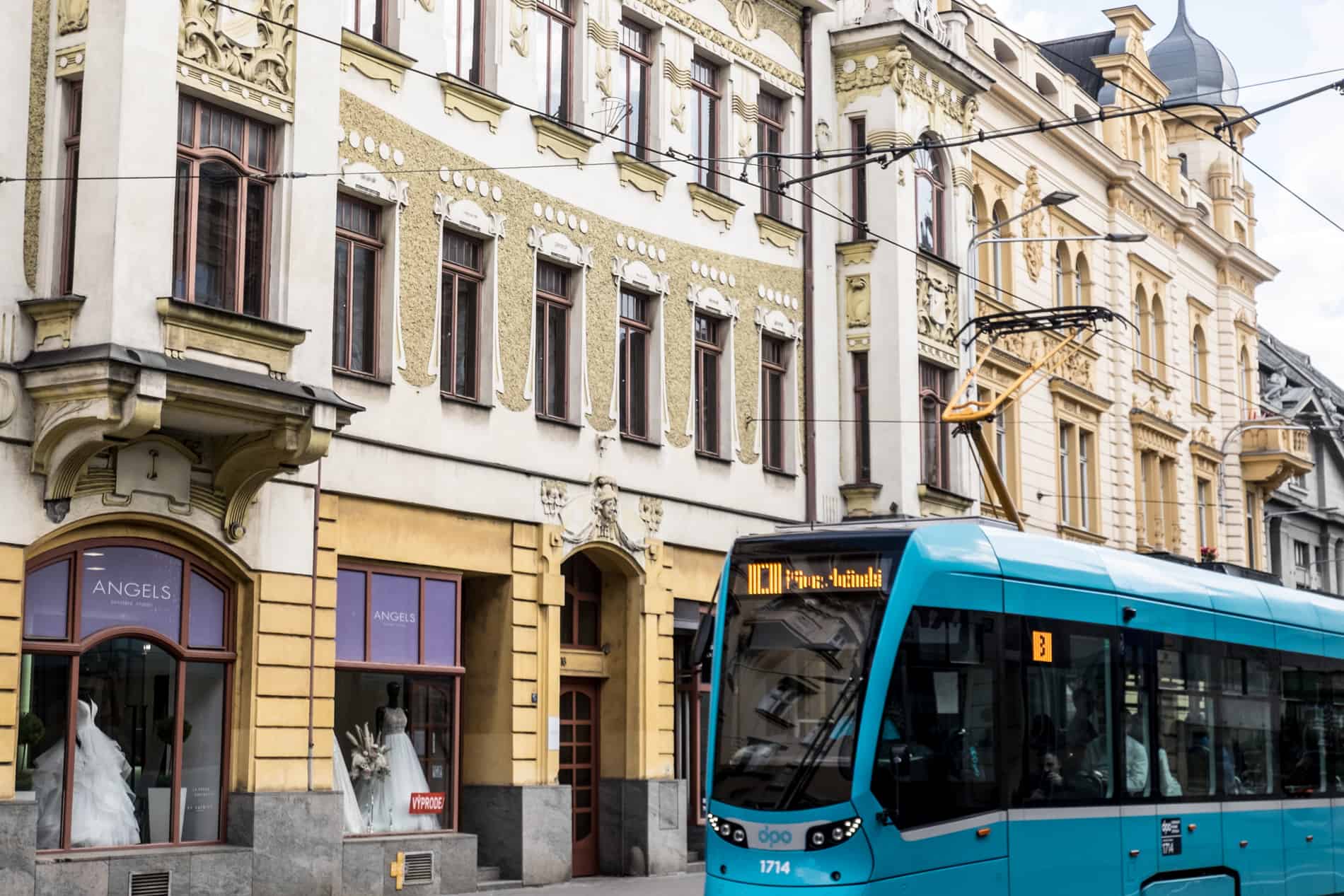
Ostrava’s public transport network gets you out to the big sites.
Where to Stay in Ostrava
One of the newer hotels, the Mercure Ostrava Center is a 4-star modern hotel housed in a historical building, minutes away from all the city landmarks and highlights. The vast breakfast spread is worth the extra budget.
The Imperial Hotel was Ostrava’s first hotel and has been hosting visitors since 1904. It’s a little dated, despite its modifications, but a legendary part of the city’s history.
The elegant and minimalist design hotel, Hotel city.city, is north of the centre but conveniently located next to the main train station, and the modern 4 Pokoje guesthouse is west. The heart of the city is accessible from both via a 5-minute tram.
Disclosure: This Ostrava travel guide has been created in partnership with Visit Czech Republic and Moravian-Silesian Region Tourism to showcase a lesser-known side of the country. All opinions remain my own.
The post Uncommon Things to Do in Ostrava, Czech Republic, to See It Differently appeared first on Borders Of Adventure.

